Winter 2023/24
LONG HAUL
Mercedes launches first long-distance electric truck
VALUE OF GOLD
Highest FORS accreditation is key driver for business growth
GOOD TO TALK
How mediation can save both money and hassle
PLUS: FORS launches upgraded Safe Driving course

CONFERENCE CALL
FULL REPORT AND PICTURES FROM THE 2023 FORS ANNUAL CONFERENCE
MAGAZINE
fors-online.org.uk
ACCELERATE CHANGE

DECARBONISE THE FUTURE DROP BY DROP
Gd+HVO ENHANCED BIOFUEL IMMEDIATELY REDUCES CARBON EMISSIONS BY UP TO 90%
WWW.GBF.LTD


winter 2023/24 STANDARD MAGAZINE | 3 Management Publisher: Matthew Eisenegger Editorial: Editor: Trevor Gehlcken Telephone: 07747 787403. Email: gehlcken@hotmail.com Art Editor: Leo Gehlcken Telephone: 01257 231521 Email: design@cvdriver.com Contributors Steve Banner, Richard Simpson, John Challen Editorial Address Commercial Vehicle Media & Publishing Ltd, 4th Floor 19 Capesthorne Drive, Eaves Green, Chorley, Lancashire. PR7 3QQ Telephone: 01257 231521 Email: matthew@cvdriver.com Advertising Sales: David Johns Telephone: 01388 517906 Mobile: 07590 547343 Email: sales@thestandardmagazine.co.uk Contact FORS: Web: www.fors-online.org.uk Tel: 08448 09 09 44 Email: enquiries@fors-online.org.uk @FORS_online (Twitter and LinkedIn) fors-online.org.uk About us Note The publisher makes every effort to ensure the magazine’s contents are correct. All material published in The Standard Magazine is copyright and unauthorised reproduction is forbidden. The Editors and publisher of this magazine give no warranties, guarantees or assurances and make no representations regarding any goods or services advertised in this edition. The Standard Magazine is published under a licence from Commercial Vehicle Media & Publishing Ltd. All rights in the licensed material belong to Matthew Eisenegger or Commercial Vehicle Media and Publishing Ltd and may not be reproduced whether in whole or in part, without their prior written consent. The Standard Magazine is a registered trademark. If you are not going to keep this magazine for future reference please pass it on or recycle it.
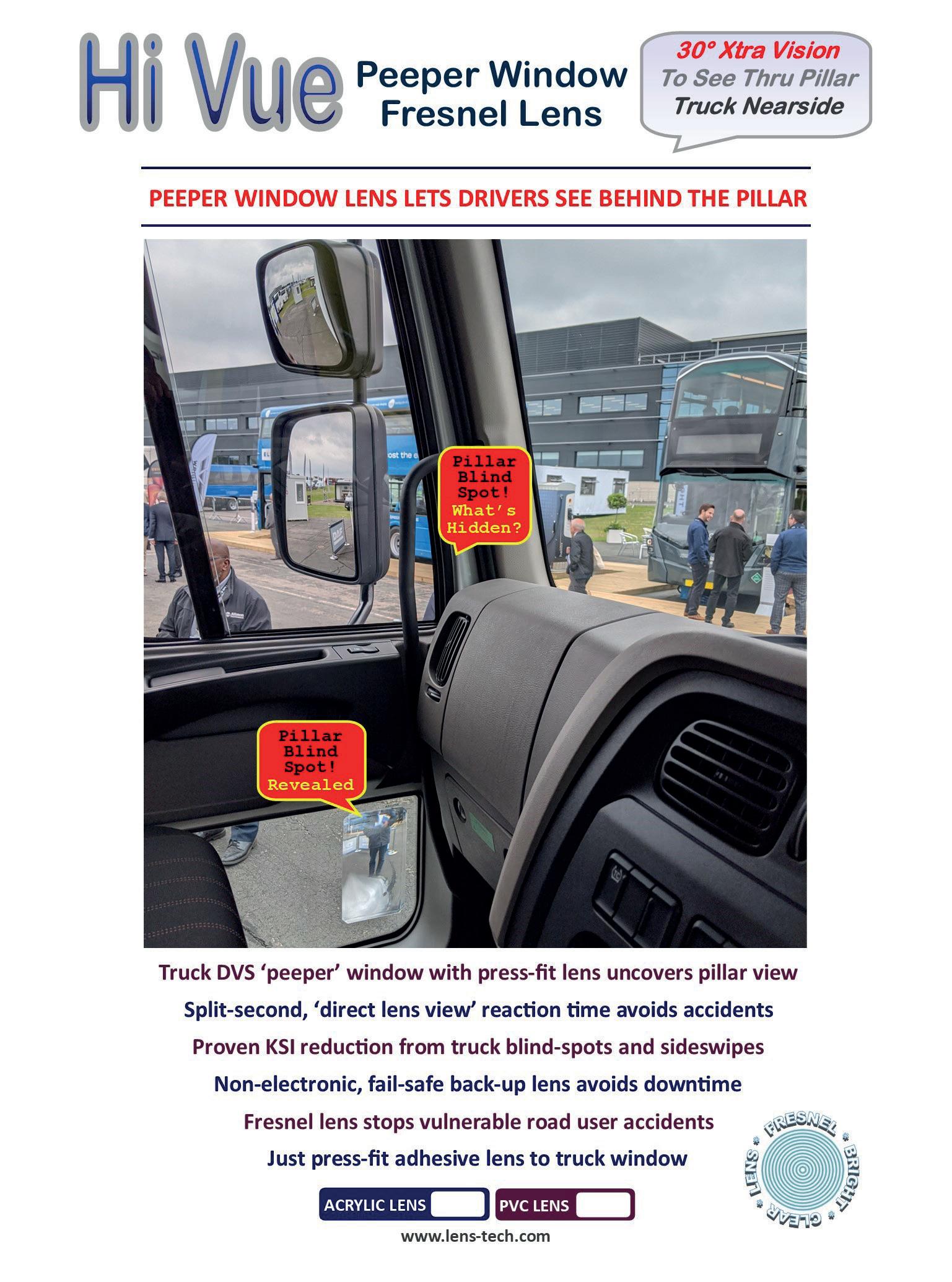 Truck Lens
Extra 30O Forward Vision
Truck Lens
Extra 30O Forward Vision
HELLO & WELCOME
Welcome to the latest edition of The Standard
The 2023 FORS Annual Conference really brought it home to me just how successful the scheme has been in improving safety and environmental awareness among Britain’s transport fleets. It was wonderful to see so many people gathering together from different spheres in life, with shared aims in mind.
Wandering around the stands of the various FORS-affiliated companies in the intervals between the speeches, I listened as problems were discussed, solutions offered and deals made. I’ll be honest – I felt proud to think that I am a part of this massive sea-change taking place in the transport industry.
In this issue, we have dedicated a large chunk of coverage of the big event. Inside, you’ll find a summary of what the speakers had to tell us, plus a spread of photos from the exhibition area. You’ll also find a link to the dedicated conference hub on the FORS website where you can watch interviews with speakers and other attendees.
But there is much more to read inside – articles which we hope you will find interesting, useful and informative.
Firstly, there’s news of the new FORS Safe Driving course. The old Safe Urban Driving and Van Smart courses have now been consolidated into one and the new course is available to drivers of all commercial vehicles, no matter how large or small.
I can’t stress how important driver training courses are and how careful transport chiefs have to be when explaining them to their staff.
It’s all very well and good transport chiefs setting up various systems for improved safety in their operations, but if the drivers themselves don’t get on board and play their part, all the effort will be wasted. If the reasoning behind these systems isn’t explained properly to drivers, some may feel resentful that their skills are being brought into question when asked to attend a training course. After all, they are professionals who drive year after year and are presumably already pretty good at avoiding incidents on the roads.
But with care, their fears can be assuaged – and once drivers get into the safety mindset, the benefits will start rolling in.

Meanwhile, with winter weather bearing down upon us as I write, our trucking specialist Richard Simpson gives us the lowdown on what tyres hauliers should be using to cope with the oddities of our British weather. Reading it, I certainly learned a thing or two about our unpredictable climate!
Our in-depth look at industry heavy hitter JCB throws up some interesting points. Using electric and hydrogen power to achieve net zero in the transport industry may be feasible for vans and trucks, but according to the JCB specialists, it just won’t do for some of the products it manufactures. So, its experts have been at hard at work to come up with alternatives that will meet zero emissions goals – and what they have produced is pretty impressive, to say the least.
Our environmental section – which we have marked up in green, in case you hadn’t noticed! – has full details of the first long-haul electric truck from Mercedes-Benz. There is also a small but fascinating article about one firm that claims to make even greener vehicles than electric trucks and vans themselves. How come? Turn to page 42 and find out.
On the legal front, our law expert Ian Jones gives some solid advice about how to avoid expensive legal battles when a major staff issue blows up. Getting in a trained mediator from outside, with no axes to grind, is the way forward, he says, as legal fees can be astronomical and cases can take months or even years to come to court.
Read on and enjoy…

winter 2023/24 STANDARD MAGAZINE | 5


28-30
Left: Winter warning
Get the lowdown on the varying uses of different winter tyres
12-25
Left: Conference call
15 pages of pictures and reports from the FORS Annual Conference 2023
34-36
Right: Counting the cost
Transport firms may soon be required to add up their total carbon footprint
26-27
Below: Operator profile
An unwavering commitment to high standards leads to success for D.A.W Logistics


6 | STANDARD MAGAZINE winter 2023/24

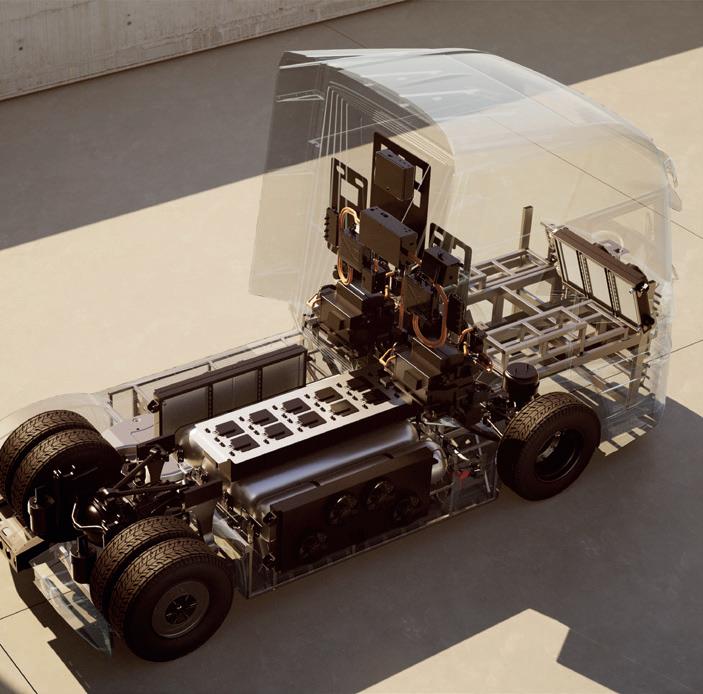
38-41
Above: the JCB way
Heavy hitter treads its own unique path towards net zero
54-55
Left: Design debut
Hydrogen gas truck firm boxes clever with a single platform
48-50
Right: Long haul
Mercedes-Benz reveals its first electric designed for long-distance work
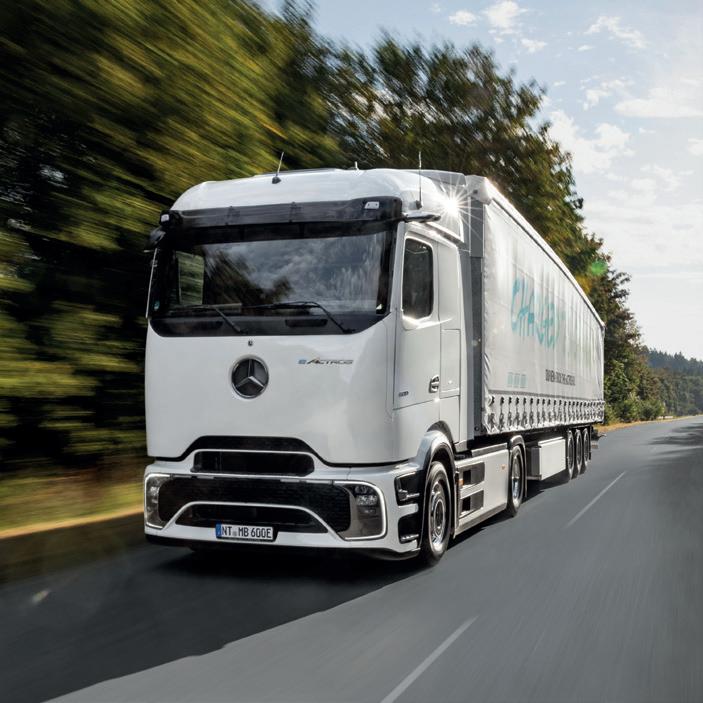
8-10 News
What’s hot and happening in the transport world right now
12-25 Conference report
Full details from the FORS Annual Conference 2023
26-27 Opening doors
How FORS Gold led to new gains for D.A.W Logistics
28-30 Winter tyres
There are many available, so which ones should you choose?
34-36 Carbon count-up
Plans for transport firms to calculate carbon emissions
38-41 Doing it the JCB way
Plant specialist has fresh ideas for eradicating noxious emissions
42 Greenest of all?
Lunaz claims its trucks are the most environmentally friendly
48-50 In for the long haul
First EV from Mercedes-Benz for long-distance work revealed
54-55 Single platform
Hydrogen truck maker reveals fresh way to cut production costs
57 Legal advice
Go for mediation to save time, money and hassle
winter 2023/24 STANDARD MAGAZINE | 7
MAGAZINE
Course upgrade
FORS driver training courses merged and updated p8
Magic mirror
New solution from Lens-Tech eradicates blind spots p8
Parking fears Engineers say EVs may damage multi-storey car parks p8
Out of film
Nearly half of all UK speed cameras don’t actually work p9
Value added Hankook’s new tyre range for transport fleets launched p9
FORS revamps driver training course Hi Vue lens sees round corners
FORS has revised and updated its driver training output with the introduction of its new ‘Safe Driving’ course. The new offering is fully redesigned and consolidates the scheme’s previous Safe Urban Driving (SUD) and Van Smart courses.
Safe Driving is delivered through the FORS Professional training portfolio and is available to drivers of all vehicle classes, from vans through to 44-tonne GCW articulated vehicles. Participants will receive the latest tuition on defensive driving to instil a safety mindset that benefits drivers, vulnerable road users and the wider public.
Course highlights include drivers’ regulatory responsibilities and the importance of safe driving practice on motorways, rural and urban roads. Importantly, Safe Driving takes a deep dive into key areas that may negatively impact individuals behind the wheel such as driver fitness, health, distraction and impairment. Safe Driving also includes a practical on-cycle session and a theory module. Both 3.5-hour modules contribute towards Driver Certificate of Professional Competence (CPC), plus mandatory Work-Related
Road Risk training as required at FORS Silver.
FORS Concession Director Geraint Davies said: “Both our previous SUD and Van Smart training courses delivered significant benefits for drivers, albeit for different vehicle classes. Our new Safe Driving course brings all the various course elements together into one redesigned package, which will provide benefits for everyone. Our FORS Professional training portfolio remains the most comprehensive training resource for drivers and managers currently available in the transport sector.”
FORS Safe Driving is available now to all FORS Professional licensed training providers. To allow time for Driver CPC approvals, a transition period exists where the previous Safe Urban Driving course may still be available. Previous courses Safe Urban Driving and Van Smart remain acceptable demonstrations of meeting FORS Silver training requirement ‘S5 Workrelated road risk (WRRR)’ if they are valid within the five-year validity period. Safe Urban Driving was launched in 2012 and has since delivered training for over 130,000 drivers. •

FORS Associate Lens-Tech has added a lens solution to its product range to improve forward visibility on trucks fitted with peeper windows, effectively eliminating the blind spot created by windscreen pillars.
anyone or anything close to the front corner of the truck.
“It’s very difficult to alleviate the blind spot created by the pillar and the truck’s nearside mirrors and a pedestrian or cyclist hidden behind it is extraordinarily vulnerable,” said Les Haigh, CEO of Lens-Tech.
The lens can improve forward visibility by 30 degrees
The company, which designs and builds Fresnel lenses for commercial vehicles, has been applying its Hi-Vue lenses to peeper windows in the lower front doors of truck cabs, which have become increasingly popular lately.
Positioned on the nearside peeper window in portrait format, the lens can improve forward visibility by 30 degrees. It allows drivers to see into the area obscured by the nearside windscreen pillar and mirror array, considerably improving their ability to spot
“DVS requires the maximum amount of nearside vision you can get from the driver’s seat, so there’s a strong push towards getting those peeper windows into the doors.”
•

EVs pose risk to older multi-storey car parks
Electric vans should be banned from older style car multi-storey parks in the UK that cannot bear their weight, according to the Institution of Structural Engineers. The group wants limits to be imposed, with the batteries of electric vehicles alone now weighing around 500kg.
The group has flagged that the greater weight is putting a strain on car parks that were built in the 1960s and 1970s for vehicles of that day and age. For example, the 1970 Austin Mini 1000 – a popular hatchback from the day –weighs 620kg, whereas the
Kia E-Niro, a contemporary electric car, weighs 2,230kg. Institution chief Chris Whapples said many of the 6,000 multi-storey car parks across the UK could be under pressure.
“Potentially if we just ignore this issue then we could have a partial collapse,” he said. “I’m not trying to create any scaremongering. Not all car parks will have to impose limits, only the very old ones, built in the 60s and 70s, which are in a very poor state of repair, have weakened over time and will probably need to have some work done to them.” •
FORS News 8 | STANDARD MAGAZINE winter 2023/24
The new ‘Safe Driving’ course is available for all drivers of commercial vehicles
Clean-up costs
Councils rake in millions from their ULEZ zones p9
Super saver
Fuel pricing expert joins FORS to help with costs p10
Fleet help
Companies join for cost-saving advice for firms p10
Shock findings show almost half of speed cameras are inactive
In a shocking blow to hopes of better safety on Britain’s roads, it has been revealed that almost half of the speed cameras in England and Wales are not actually working.
A recent Freedom of Information (FOI) request showed that all eight fixed speed cameras in Northamptonshire were inactive. And Gwent in Wales
Leicestershire has a total of 18 fixed speed camera sites, yet only four of these are working
only had one active speed camera out of the 31 in place.
Of the 13 police forces that responded to the FOI request, six had over half of their speed cameras standing inactive at the time of reply.
In Derbyshire (113), Essex (110) and Devon & Cornwall (110) – the regions across England with the most speed cameras – each had at least 40 per cent incapable of catching speeding drivers.
Derbyshire has more speed cameras out of action than any other region, with only 20 of the 113 across the county capable of catching speeding motorists, leaving 78 per cent of the devices inactive. The West Midlands had only five per cent of their speed cameras standing inactive, with 62 out of 65 devices in operation.
Leicestershire has a total of 18 fixed speed camera sites, yet only four of these are working, leaving 78 per cent inactive.
Cambridgeshire has 17 inactive speed cameras out of the 46 within the region (37 per cent inactive). Neighbouring Bedfordshire has just eight per cent devices that are operational. Only two areas – DyfedPowys in Wales and Suffolk – had all speed cameras working. But both police forces have just four devices. •
Below: Speed cameras were originally hailed as a game changer in road safety – now almost half of them don’t work
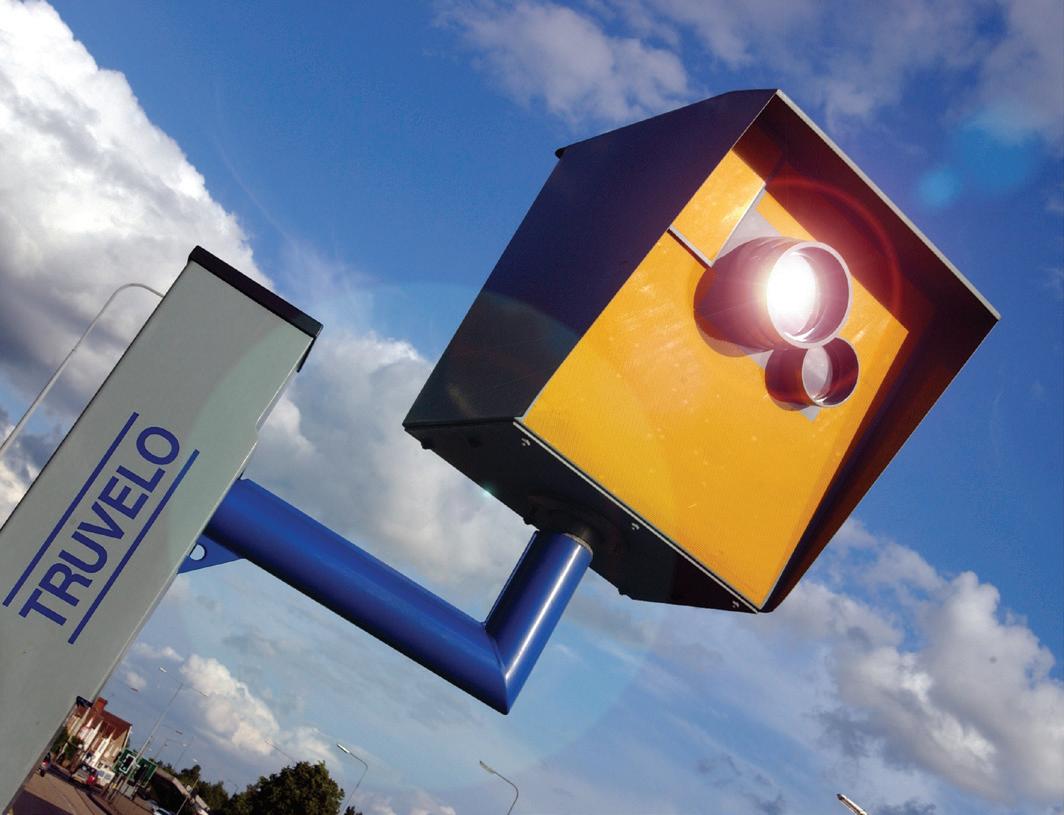
Damage deal
Leasys announces waiver deal for its customers p10
Hankook offers Laufenn tyres for budget fleets

Tyre manufacturer Hankook has launched a commercial truck and bus tyre range. Laufenn tyres focus on the second tier of the UK market – ideal for customers who focus on value, reliability and quality associated with an established, premium tyre maker.
Laufenn covers the main range of tyre sizes for regional haul use, last mile delivery, public transport and construction. Developed by experienced engineers using premium tyre technology, the
Above: Laufenn tyres are aimed at fleets which focus on value
Laufenn range ensures efficiency, reliability and delivers maximum mileage performance. All patterns are 100 per cent regroovable and retreadable to maximise the tyre’s life cycle and reduce costs to the operator. The initial line-up has been developed to meet more than 85 per cent of the total market needs, with most of the sizes offering 3PMSF labelling. •
New boost for transport connectivity
Work on road improvements and rail upgrades will boost business and improve connectivity across the UK, Transport Secretary Mark Harper has announced in his response to Lord Hendy’s Union Connectivity Review.
The measures lay the foundations for stronger UK connectivity and economic growth by increasing access to skilled labour and opportunities, he said.
Harper added: “We are committed to delivering growth opportunities across the United Kingdom.
“We are announcing support for projects that will boost connectivity and enhance transport connections across the UK. These projects will identify schemes that can bring economic benefits to people across the UK.
“I’d like to thank the Scottish Government, Welsh Government and Northern Ireland Executive for working collaboratively with us on these projects and I look forward to continuing to work closely with them on improving UK transport.”
FORS News winter 2023/24 STANDARD MAGAZINE | 9
Portland Pricing agrees new partnership with FORS
Fuel pricing specialist Portland Pricing has announced a new UK partnership with FORS. The service, provided by Portland Analytics, has become the official provider of fuel price information to FORS operators, providing insights to enable effective fuel price management and cost savings. The York-based company has been publishing UK market fuel price data for over a decade and aims to make fuel purchasing straightforward for commercial users. The new agreement means Portland will become a FORS Affinity Partner, with discounted rates available for FORS operators.
Regardless of whether a company purchases fuel itself or contracts this part out, it has been well documented that movements in diesel and HVO prices can seriously impact budgets.
UK bulk diesel prices have fluctuated over the last year, moving between £1.04 and £1.57 per litre since September 2022, making it essential to reflect accurate fuel costs in haulage agreements and to secure the lowest possible price versus the wholesale base cost. The
client base for Portland’s pricing service spans multiple sectors including logistics companies, fleet operators, manufacturers, wholesalers and retailers.
Through a subscription to Portland’s online pricing portal starting from £40+VAT per month, businesses can gain access to an industryleading fuel surcharge index and calculator, get visibility of underlying wholesale fuel costs to track premiums charged by suppliers, and understand when to buy to take advantage of market movements. Portland’s service also shows the average price of bulk fuel by region, prices and emissions data for alternative fuels such as HVO, as well as average fuel card and forecourt prices.
Director of Portland Analytics, Mike Johnson, said: “We are engaging with FORS Operators to provide access to our pricing and analytics services.
“Partnering with operators is a privilege and our aim is to work closely with members to deliver improvements to fuel procurement strategies, to further enhance FORS’ already class-leading offering.” •

Bridgestone and Webfleet offer money-saving solutions

Bridgestone and Webfleet, FORS Associates, are proving their worth to commercial fleets with four money-saving solutions now in place to ease their financial pressures. Both businesses have commissioned an in-depth study to gain an insight into transport business needs. The research gives a glimpse into fleets’ financial concerns and the difficult decisions being considered as a result. It was conducted among more than 200 UK fleet decision makers through online polling by research consultancy Perspectus Global, in an attempt to appreciate the economic landscape from their unique perspective and how they plan to navigate their way through it.
Some startling statistics emerged, including 85 per cent of commercial businesses admitting to being tasked with
cutting fleet spend. More than a third of HGV operators (36 per cent) think they will slim down, while unsurprisingly, the biggest cost increase for fleet operators was fuel, at 69 per cent.
Bridgestone and Webfleet’s four support solutions are:
• Access to an indepth Duravis and Ecopia research study with Coventry University to calculate the fuel savings that could be realised by operating on both products
• Webfleet savings calculator, where cost reductions are outlined in a few seconds
• A Webfleet solution adviser offering fleet efficiency improvements with data-driven insights
• Keeping safe on the road downloadable e-books, where valuable insights and tips are given about tyre maintenance and best practice advice. •
Damage waiver for van fleets
Leasys is supporting its fleet customers by waiving the sums it would normally charge for vehicle damage, up to a certain amount, and therefore helping firms to save money and hassle by
preventing end-of-contract charges. The waiver provides operators with peace-ofmind motoring and operates within the BVRLA industryrecognised standard for fair wear and tear. •

FORS News 10 | STANDARD MAGAZINE winter 2023/24

Eliminate the stressful and time-consuming job of manually chasing, collecting and downloading driver cards and vehicle unit tachograph data.
Let the NEW Tachomaster DOT device remotely download your tacho data daily. Monitor driver availability, work, drive and rest periods live and massively reduce driver infringements.
With zero upfront costs, no additional sim card charges and pay as you go. What have you got to lose?
£14.95 PER VEHICLE PER MONTH REMOTE TACHO DEVICE £5MORE PER VEHICLE PER(OPTIONAL)MONTH ADD TRACKINGVEHICLE FOR Tachograph Analysis I Vehicle Tracking I Transport Management System Driver Licence Checking I Walk-Around Vehicle Checks I www.roadtech.co.uk WWW.TACHOMASTER.CO.UK
01923 460000 The DOT device is only available for Tachomaster customers, and Tachomaster charges apply. Get stress FREE tacho downloads Electric Vans
CALL
Words: Matthew Eisenegger
FORS CONFERENCE 2023 – THE BIGGEST AND BEST YET
FORS welcomed its largest ever delegation to the sixth Annual Conference at the International Convention Centre in Birmingham
With the theme for 2023 ‘Building a resilient FORS Community for the road ahead’, the event featured more than 40 exhibitors, plus a diverse range of speakers with practical advice on maintaining rigorous processes for compliance and safety, as well as how to deliver greater business efficiencies.
Presentations and panel discussions from the FORS and GSAG (Governance, Standards and Advisory Group) teams covered a range of topics including accreditation, stakeholder management, training and updates to the FORS Standard.
It had been 16 months since the last conference, due to operator feedback that an event in Q4 was preferable. The location returned to its Birmingham roots, being hosted at the International Convention Centre, with the Midlands being best placed to serve operators based in the north and south alike. The venue was also the perfect place to host the 400+ transport professionals, thanks to its spacious layout and modern fittings.
When deciding on the theme ‘Building a resilient FORS Community for the road ahead’, the FORS team aimed to curate a line-up of talks that not only gave practical advice to operators on how they could overcome the many challenges facing the industry but also instil a community spirit.
Delegates were also informed about
updates to the FORS Professional training portfolio as well as a redesign and simplification of the website.
Looking to the future, the FORS team spoke of targeting emerging and growing sectors such as cargo bikes and single van operators, as well as a focus on growing accreditation for Passenger Carrying Vehicles (PCVs). Updates to the FORS Standard are expected to be published
We are aligning our priorities to what matters to operators
at some point this year, with Version 7 effective some time after. Minor changes to most existing requirements are expected in Version 7, but in line with best practice, operators will see the biggest difference in environmental expectations.


Building a resilient FORS Community for the road ahead Post-event Report FORS Annual Conference 2023 FORS Annual Conference 12 | STANDARD MAGAZINE winter 2023/24


Conference delegates check in for the biggest and best annual event so far
FORS Annual Conference winter 2023/24 STANDARD MAGAZINE | 13
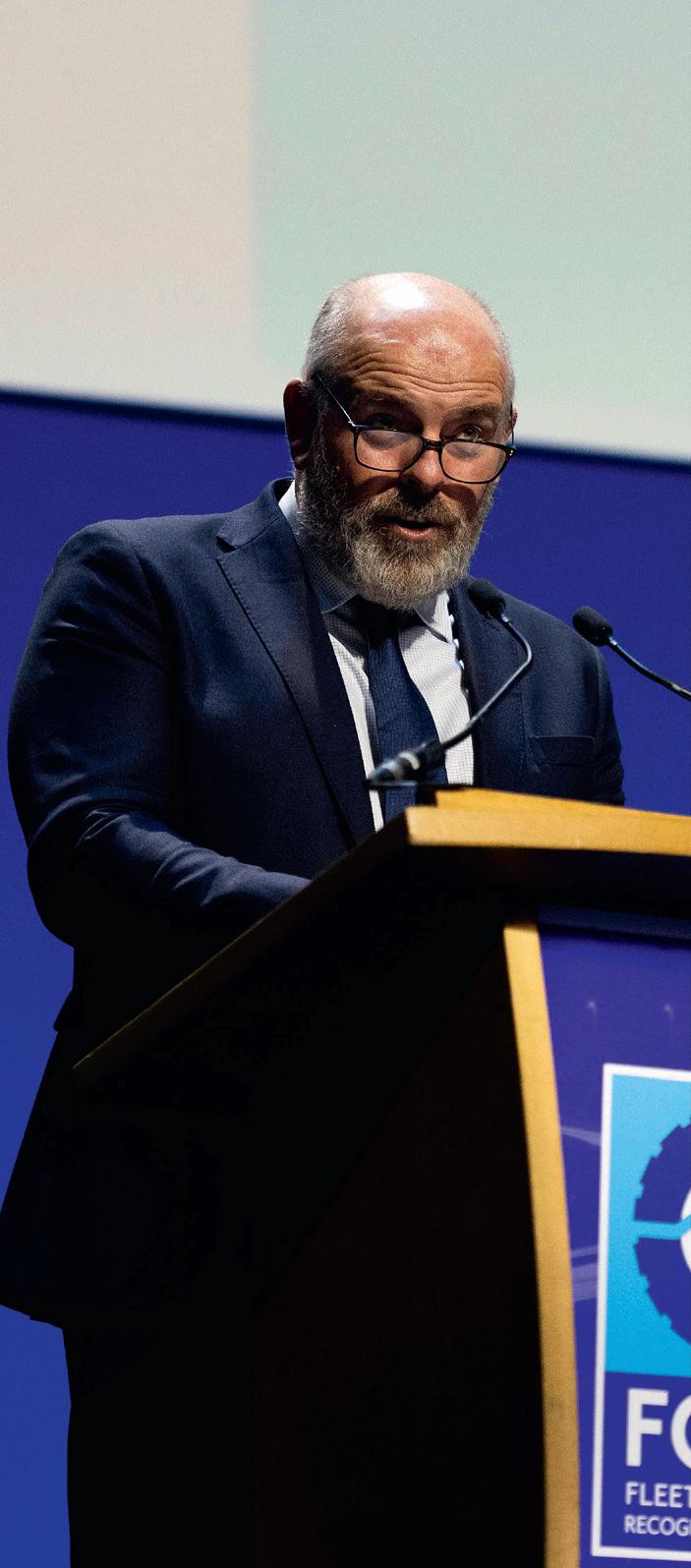
Andy Salter, event chairman
Returning for another year, Andy Salter excelled in the role of chair. His role as managing director for DVV Media, with DVV Media being a key partner of FORS, meant that he was the perfect person for the job.
Salter’s opening speech centred around the already recognised resilience of the industry. He referenced the time of soaring diesel prices, driver shortages, supply chain crises and (of course) Covid-19 – which was only a couple of years ago. Giving his overview of what makes a business resilient, he stated that having the right processes, planning and driver management will deliver efficiencies and savings across the board. Salter championed FORS for driving up standards across the industry and helping to instil the right behaviour across fleet management, which he said ‘creates the true resilience of the fleet industry’.
Though, all of this – as he declared – is underpinned by the industry working together. Salter ended his welcome with

‘going forwards, collaboration could be one of our greatest skills’.
FORS Concession Director Geraint Davies and Glen Davies
Having attended many conferences before as a delegate, this year’s event was slightly different for FORS Concession Director Geraint Davies. The audience learned about Davies’ love of vehicles from a young age, having entered the transport industry with his first job at Bridgens Transport (after a short role in a crisp packing factory!). His journey led him to a 22-year stint at FORS Gold Operator John Raymond Transport, where his most recent role was chief operating officer. Alongside this, Davies has served as a director on the RHA Board, chaired the Logistics UK Welsh Freight Council and chaired the UK Road Freight Council. He also shared his experience as a FORS Auditor and FORS Trainer, showing that the accreditation scheme is in good hands.
With a slightly different start to his career, Glen Davies took the stage to
give an overview of his background. He shared that he started in the Royal Corps of Transport aged 17 and within a few years held every driving licence category possible. After reaching the pinnacle of his career heading up compliance, safety, training and operational capability across a 9,000-vehicle fleet in 53 locations, Davies revealed he was recruited by Transport for London as the FORS Manager. Due to its success, it was Davies’ team that commercialised the scheme through its first concession in 2015. Since then, he has been granted the Freedom of the City of London for his contribution to the sector, become a Liveryman of The Worshipful Company of Carmen, as well as been the technical author for the CILT’s Transport Manager CPC courses and the editor for both Lowe’s and the RHA operator handbooks.
The FORS experts then moved on to share what’s been happening behind the scenes at FORS for the past year-and-ahalf, covering the following four areas: accreditation, stakeholder management, training and digital.
Glen Davies started with accreditation, highlighting the creation of the ‘Future of Accreditation’ programme in the summer of 2022, which will continue until at least 2024. In this programme, the Bronze audit has been redesigned to ensure it is fully aligned to Operator Licence undertakings and, for consistency, clearly cross references to DVSA guidance and Earned Recognition.

FORS Annual Conference 14 | STANDARD MAGAZINE winter 2023/24
Event chair Andy Salter
Glen Davies – long service to the transport industry
Geraint Davies – lifelong love of vehicles
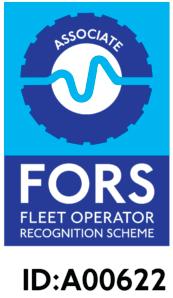



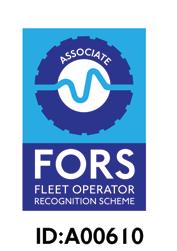


Compliance Guide Progressive Safe System requirements • Blind Spot Information System (BSIS UNECE Regulation 151) • Moving Off Information System (MOIS UNECE Regulation 159) Camera Monitor System Audio Warnings Talk to the fleet safety experts at Motormax 0345 9001312 info@totalcompliance.co.uk totalcompliance.co.uk Industry Leaders For Transport Consultancy & Training Contact Us Today For Your Transport Consultancy and Training Needs The UK's Leading Nationwide Transport, Logistics and Construction Consultancy and Training Provider • Differentiate your company from competitors • Improve fleet management • Enhance fuel efficiency ALLMI Training FORS Accreditation Driver CPC Training External Transport Manager DGSA Advisor Service Convey Tachograph VR Headset Courses Classified winter 2023/24 STANDARD MAGAZINE | 15
The team has also published a new competence framework for the fleet auditor and produced five progressive training modules. To ensure continuous improvement, a new post-audit satisfaction survey has been established too.
Geraint Davies took the podium to talk about stakeholders. He said: “We know that FORS cannot succeed without the collaboration with key stakeholders” and took the audience through some of the organisations that FORS has been fostering constructive relationships with, such as Logistics UK, RHA, DVSA, Office of the Traffic Commissioner and Mineral Products Association. Geraint Davies also referenced the recent Accredited Operator Survey, stating: “We are aligning our priorities to what matters to operators.”
After a revealing poll (FORS has trained 47,000 drivers so far this year via FORS Professional), Glen Davies spoke about the improvements to the training programme. To name a few: all Practitioner courses have been redesigned and additional courses have been added, FORS Advanced Practitioner has been introduced and LoCITY has had a complete redesign. Glen Davies also launched a new course ‘Safe Driving’ during his address, which is to replace the Safe Urban Driving and Van Smart courses.
To conclude their round-up of activity, Geraint Davies spoke about digital transformation. He said: “FORS Online and the website provides the shop window to FORS.” Geraint Davies informed the audience that the web interface has been redesigned and stabilised, plus a new feature has been introduced where operators can amend their fleet details themselves without having to contact the FORS Helpline. FORS’ concession director also announced that there will be a new digital audit solution rolling out next year, which will ensure an even better audit experience.
Looking forward, the two alluded to what operators can expect in the future. They spoke about plans to continue improving FORS Professional, target emerging and growing sectors (such as cargo bikes and single van operators), focus on growing accredited Passenger Carrying Vehicles (PCVs) operators and, of course, the upcoming launch of Version 7. Geraint Davies informed the room that Version 7 of the FORS Standard will be published
in 2024 and will be effective some time after.
He said: “We cannot ignore environmental and sustainability requirements by clients and specifiers” and gave the assurance that there is minimal material change to the existing requirements. Geraint Davies said FORS will be fully supportive in providing guidance, toolkits and training to meet Version 7 requirements.
Senior Traffic Commissioner
Richard Turfitt
Richard Turfitt started his presentation by asking the audience: does the name ‘Traffic Commissioner’ highlight what the function does? Turfitt revealed that he was at the conference to demystify that job title and show that the work they do goes beyond what you see in the trade press, so the audience can ‘use our staff to the best effect’.
Turfitt shared that he is often asked what the main problem he encounters at a Public Inquiry is. He highlighted it was management and the failure to manage the O Licence. Too many operators are overlooking key compliance, said Turfitt, and his job is judging whether an operator has been failing to notice or do something that they should be. So, Turfitt asked, how do you exercise effective oversight over your operation? He outlined that it’s not just about signing up for a scheme, but you need to be actively engaged in managing compliance and not treat it as a tickbox exercise.
Turfitt detailed key areas that operators in the audience should be looking at to ensure they are compliant. One of
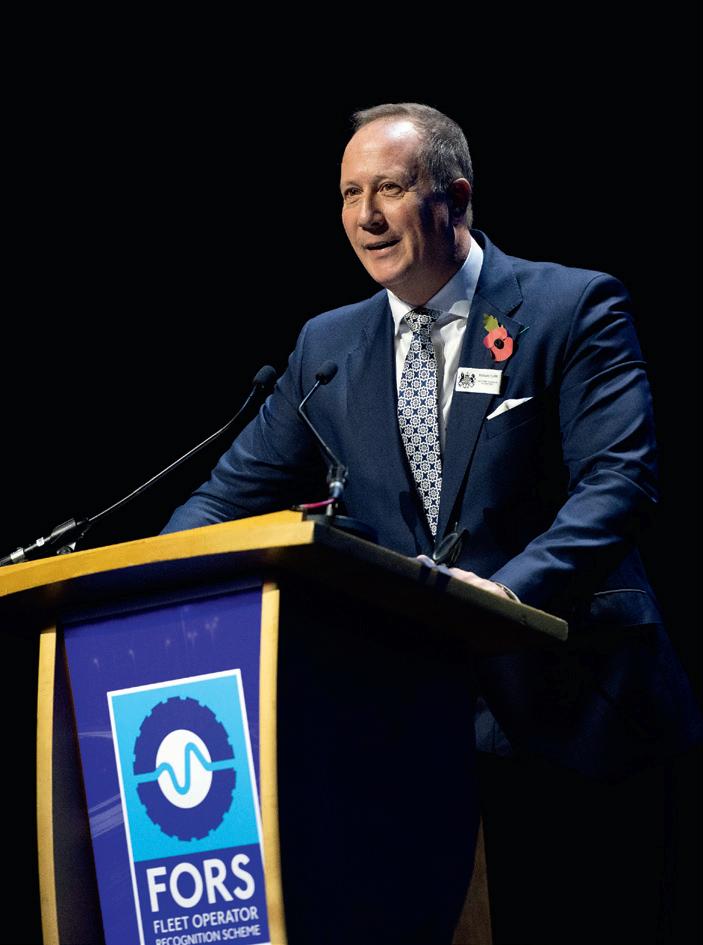
these was ensuring ‘active involvement by those at the top of the tree’, so they’re clued up on every aspect of their operation. Operators should be signed up for updates from FORS and the Office of the Traffic Commissioner, so they are kept up to date with changes and always exercising continuous management.
Turfitt also stated that senior leadership should always be checking control measures, such as drivers’ hours, and he’s ‘appalled at how many operators say they skip daily walkaround checks’.
Turfitt emphasised the key message to take away is to monitor key performance indicators (KPIs). Are infringements being recorded, addressed and action taken as a result? He advised: “Take a risk-based approach to all your management and seek evidence when you’re having your audit.”
Turfitt shared that there is a plethora of easy-to-understand resources and guidance available to help, eg recent guidance published on load security. He added: “I cannot provide you with a binary checklist – but I can provide you with the tools needed to help you.”
Paul Fox, Managing Director of Fox Group
Paul Fox explained that Fox Brothers is a fourth-generation family business, established in 1932. The company started its FORS journey in 2016, gaining Gold accreditation in 2020.
Fox spoke to the audience about the drive for decarbonisation, asking the audience what can we do. He said: “There’s lots of things we can do, but we need to make sure we persuade leadership that accreditations like FORS add value to your business.”

FORS Annual Conference 16 | STANDARD MAGAZINE winter 2023/24
Richard Turfitt – demystifying the role of traffic commissioners
Paul Fox – recounted his firm’s journey to FORS Gold
Fox recounted his FORS journey and how once the firm got to Silver, it automatically wanted to go to Gold. Being FORS accredited has won them more business. Fox said: “After two years, there was an acceptance in our business that FORS was absolutely crucial – in the way we win work and train drivers and managers.”
He added: “Measuring our carbon footprint is important for top-tier contracts, so we’ve made that a priority. FORS Gold helps encourage that continuous measurement and making changes to be more sustainable is key.”
He exhibited pride at being the first company in the UK to acquire an allelectric tipper truck.
Fox’s talk ended with the recommendation that Silver operators should go for Gold. He said: “It’s worked for us”.
Mark Cartwright, Head of Commercial Vehicle Incident Prevention Team, National Highways
Mark Cartwright introduced firstly National Highways then himself to the audience. His latest career move, after an impressive 33-year career in logistics, was in 2020 when he joined National Highways. He is now responsible for being a trusted voice in the industry and raising the profile of National Highways. Cartwright highlighted that National Highways has no enforcement powers, but the organisation does work with Traffic Commissioners and other bodies.
Admitting the statement was controversial, Cartwright said: “I don’t care if you’re compliant – I want your vehicles to be safe. I say that with tongue

in cheek!”
His presentation centred around the importance of road safety and he shocked the audience with the statistic that people are 90,000 times more likely to be in a road incident than win the lottery.
Cartwright revealed that National Highways has a target of zero road deaths per year, but the team can’t reach that target without the help of operators. He said: “We need difference. Look around you, you’re the difference.” He shared the ‘Driving Change. It’s Personal’ campaign from National Highways, which is centred around the premise that vehicles don’t crash, people do. Every incident has a profound effect on the people that are affected and their families.
Cartwright acknowledged that he was preaching to the converted as attendees were ‘probably running their fleet well as you’re here today’ but he stressed the importance of influencing the supply chain. He said he works with organisations with robust health and safety systems, but there’s a blindness to what’s actually going on out on the roads – and this needs to change.
The audience can be that change, stated Cartwright. His lasting message was that operators should continue to manage their own fleets properly, but also talk to health and safety teams and engage with leadership around their supply chains. He ended: “We all have a role to play to raise the standards around us.”
Marian Kitson, DVSA Director of Enforcement
Marian Kitson said her job title might
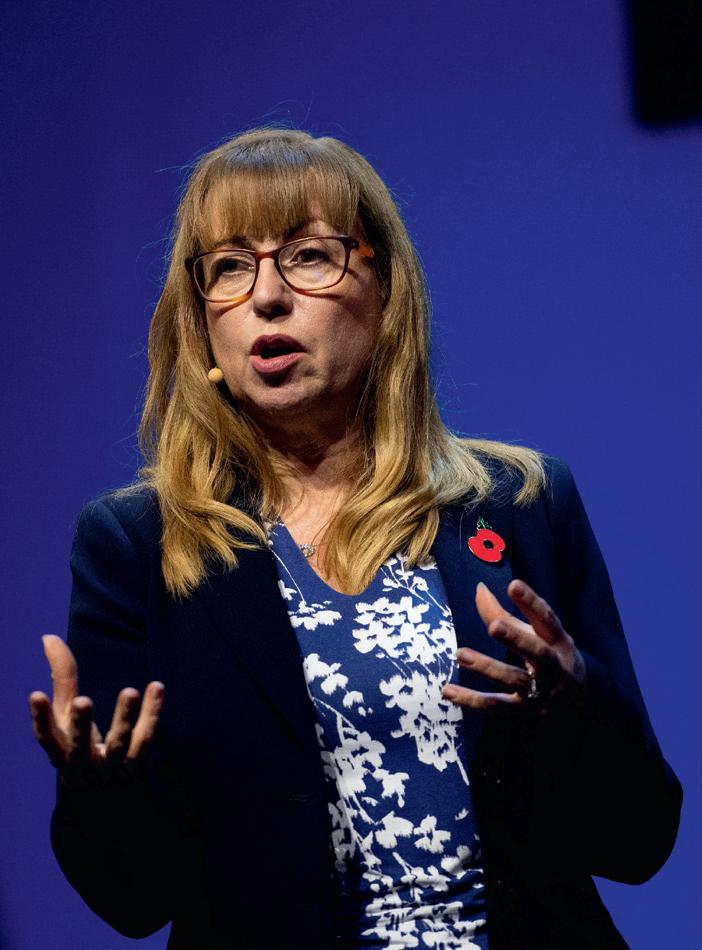
suggest that it’s all about catching people who are doing wrong, but it goes beyond that, as the DVSA ‘wants to create a framework where people can be compliant’. She recognised that the room is full of ‘business people who want to be compliant’, but wanted to educate the audience about how the DVSA can support operators in doing so.
The DVSA’s vision for 2030 focuses on five guiding principles, Kitson said. The centre of the vision is to make the roads safer, as well as make transport greener and healthier. Kitson also spoke about harnessing the data that is available to achieve a better road safety outcome, which is ‘fundamentally important now and in the future’. She highlighted the importance of being part of the change towards a more technological future.
Delving deeper into the sustainability agenda of the DVSA, Kitson said: “We MUST improve the air quality in the places we all live.” She disclosed that a tyre on a car is around 1.5kg lighter at the end of its life than at the start, so every individual tyre is giving off particles into the atmosphere. She then moved on to talk about evolving technologies, sharing that one in eight cars sold by 2030 will have several elements of automation and self-driving, so the DVSA is preparing for this.
Kitson spoke about data in more detail, as ‘we know that data will help us to operate a better road network’. With more data, operators are able to monitor vehicles continuously. The credibility of the data is important too, so the DVSA is doing some work around testing, revealed Kitson.
She asked: “So, what must we do?
What must the DVSA do? What must we do in partnership with everyone in the transport industry?” She recognised that the DVSA was well established in setting standards, and assessing and testing. But the organisation wants to put equal emphasis on informing, educating and advising operators. Kitson said: “We are encouraging genuine behaviour change – that’s why there is a big push for us in that area”.
Kitson finished her address by giving examples of how the DVSA has used automatic number plate recognition (ANPR) data to ensure compliance. She stressed that the DVSA goes beyond roadside checks, and her team is also looking at opportunities to achieve compliance through the use of data and technology. There is also some work going on into how people enter the
FORS Annual Conference winter 2023/24 STANDARD MAGAZINE | 17
Mark Cartwright – impressive career in logistics
Marian Kitson – message of support from DVSA
industry and act on behalf of the DVSA, as well as how the DVSA collaborates and learns from other industries outside of transport. Her final message was that the effort FORS Accredited Operators are putting in to stay compliant is worth it, as the DVSA is working hard to make sure all vehicles are compliant and enforcing that where necessary. This will enable all, including those FORS Accredited Operators, to benefit from driving on safer roads.
Shireen Ali-Khan, engagement specialist at Women in Transport
Shireen Ali-Khan started her slot with the strong statement: “Transportation is the lifeblood of our society... but it faces persistent challenges, such as the underrepresentation of women and minority groups.” She joked that she ‘only had ten minutes to change the world’ and gave four tangible actions to the audience around what they could do to make their workplaces more inclusive.
The first step, outlined by Ali-Khan, is ‘Attraction’. Attracting women to the field would involve challenging stereotypes, communicating the diversity that this field offers to everyone and advertising salaries that are competitive.
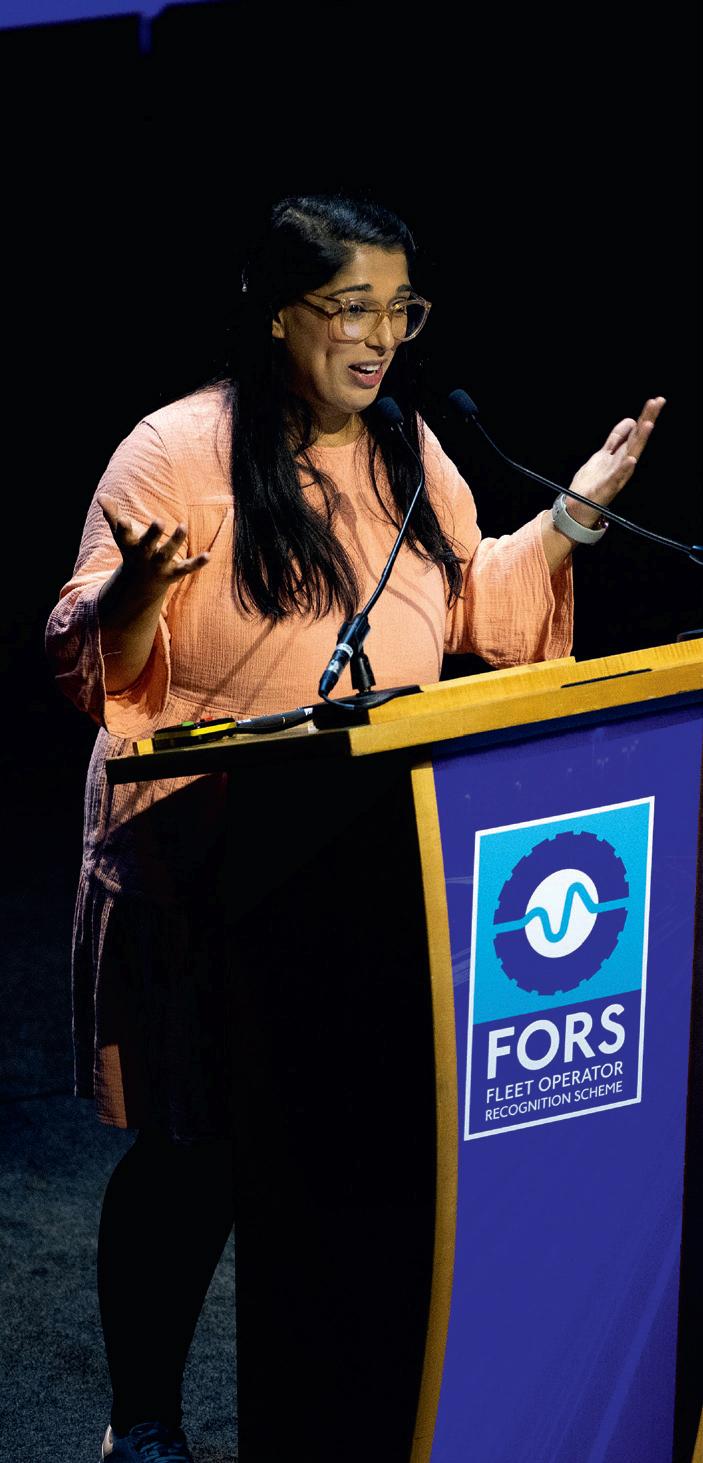
Mentoring, she said, is also a good way to champion and push people to go for opportunities. Ali-Khan also outlined that if we want to have a mix of people in the sector, we need to promote the benefits of women working in transport.
‘Retain’ is the second step, and AliKhan said businesses need to ‘create an inclusive and supportive environment for women to flourish’. This includes offering flexible working that caters for all life stages that an employee may be going through. To sum it up, she stated, “Ultimately, it’s about having all voices heard.”
Ali-Khan said the third stage is ‘Develop’. Improving training, encouraging mentoring and creating networking opportunities were all cited as actions the audience could take, within the means of their organisation of course.
The final step is ‘Growth’, which is about ‘setting targets and being clear about what we want to achieve’. To do this, operators were advised to advocate for gender diversity across the industry and try to influence policy and regulations where they can.
The talk finished outlining the rationale for why operators should start to look at the make-up of their organisations. Ali-Khan said: “It’s more profitable to have a diverse team and contribute to having a more equitable society.” We’re in a new era of understanding, she declared, so this is a great opportunity to get ahead of the curve and start reaping the benefits of encouraging a more inclusive workplace. She finished with: “Let’s work together to build a sector that is truly welcoming and empowering.”
Rebecca Jenkins, former logistics business MD
Rebecca Jenkins took to the podium to give an invigorating speech on business resilience – the key theme of the day. She gave the example of when she was working with her former client The Body Shop and was given two weeks by the leadership team to turn things around. Jenkins’ first lesson in business, as she recounts, was that she didn’t have to have all the answers, and it’s okay to admit that you don’t.
Similar to Andy Salter earlier on in the day, Jenkins listed all the uncertainties we’ve faced and have overcome in recent times. She said we’re still ‘living in a world of massive uncertainty, so you have to get comfortable with uncertainty’.
So, how do we build resilience in our businesses when all around us we have an uncertain world?
Jenkins shared three pointers that would help operators have a prosperous, resilient business. The first was a ‘growth mindset’ and she first heard of this concept in a Tony Robbins book. Having a fixed mindset (the opposite to a growth mindset), as expressed by Jenkins, would mean your business would be stagnant. Instead, operators should be challenging the status quo and see ‘problems as opportunities’.
Moving onto the second pointer, Jenkins asked: “What about your team? Do they see problems as opportunities?” She stressed that it is not our technology or systems that hinder success, it’s the people who manage those. Hence, operators should empower their teams and make sure they know that they have some control over their area of responsibility.
The final piece of the puzzle was ‘pursue relentless innovation’. Jenkins cited companies that were no longer with us, which she believes is because they didn’t act fast enough to evolve. She gave tips on how to ensure this continuous improvement runs through the culture of
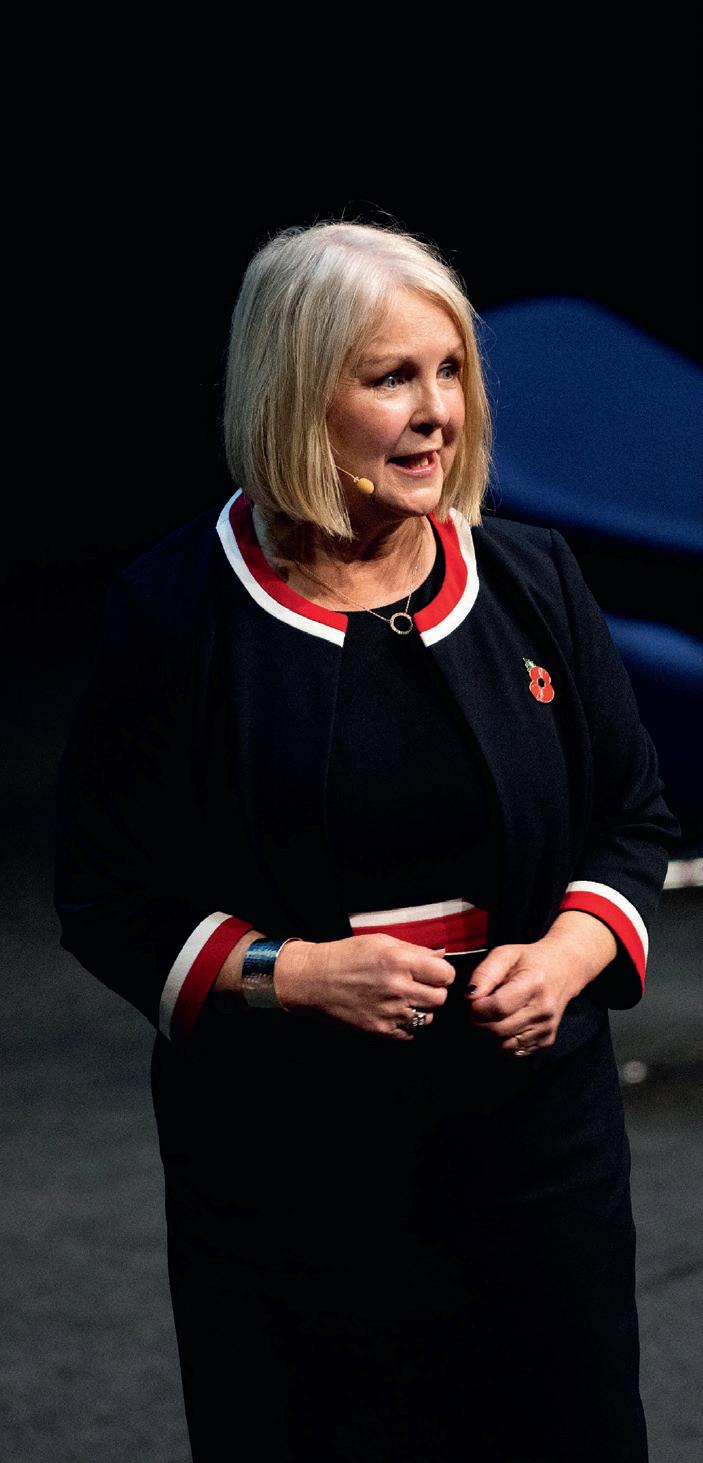

FORS Annual Conference 18 | STANDARD MAGAZINE winter 2023/24
Rebecca Jenkins – stressed the importance of resilence
Shireen Ali-Khan – women in transport under-represented
Empower your drivers. Boost productivity.
With Webfleet you get it done.
Your drivers are essential to your business. When they’re out on the road, you want to be sure they have all they need to do the job safely, efficiently and with minimum stress. Webfleet equips you and your drivers with market leading tools designed to make their work simpler, safer and better.








Remaining Driving Time Remaining Orders today Remaining 6 Next upcoming orders Inselstraße 22, Leipzig, 04143 Gustav-Adolf-Straße 2-16, Bad Dürrenberg,... Reichersdorfer Straße 9, Bad Lausick, 04651 Georg-Schwarz-Straße 16c, Leipzig, 04179 Franz-Flemming-Straße 27, Leipzig, 04179 01:30 AM 02:45 AM 05:00 AM 11:20 AM 02:45 PM OptiDrive Excellent 9.0 Vehicle Transport 014 Tap to navigate 5 h 5 min Find out more: webfleet.com | +44 208 822 3605 Let’s drive business. Further.
a business. Jenkins finished the story of what happened with The Body Shop – in the eleventh hour, a member of her team came up with an incredible idea. That idea was to put the first-ever natural gas vehicle on the road in the UK, an idea which the leadership team loved and which helped her keep the client.
Anthony Marcou, UK Commercial Consultant
Following networking over lunch, Anthony Marcou started the last part of the day representing headline sponsor Drivetech. He opened with the message that ‘every person in this room can make a change to help improve road safety’. He divulged that the ripple effect of road crashes affects more than 500,000 people in the UK every year, as 136,000 people were killed or injured on our roads in 2022 and each one is likely to have family, friends and colleagues.
Marcou asked the audience what they think the average cost of a fatal accident is. Those who thought above £1.5 million were correct – the actual answer was £2.3 million, he said.
Citing his experience of being a fleet manager, Marcou said the role is one of the toughest out there. He also declared that ‘investing in fleet today is becoming ever more challenging with costs increasing’. With this in mind, Marcou asked: how can we manage risk?
Firstly, he stated, Drivetech recommends having systems in place to identify high-risk drivers and invest in face-to-face training for that group. E-learning might be a suitable route for lower-risk drivers and Marcou said that
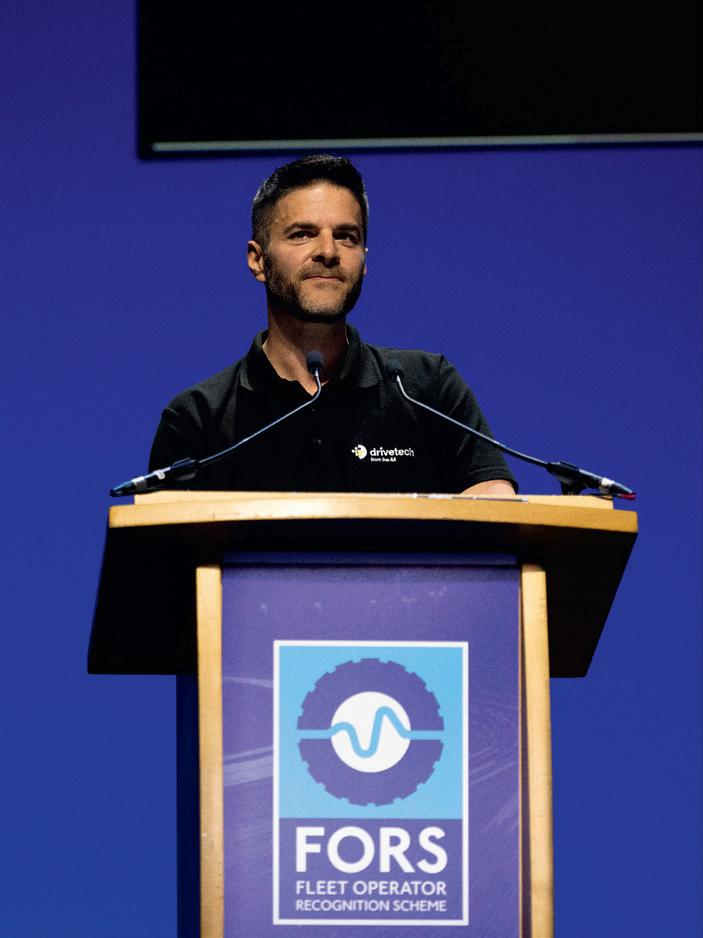
Drivetech customers tell them it proves to be successful. You can also look at trends to identify areas of improvement so you can prevent incidents, he advises. Marcou gave an overview of Drivetech’s aims – create more awareness and confidence for drivers, advise how personal choices impact driving and decrease risk and environmental impacts. A poll answered via Slido revealed that most of the audience think their budget isn’t sufficient enough for safety, which is quite alarming. Marcou ended stating that Drivetech is here to work together with operators to ‘create safer drivers, safer roads and safer communities’.
FORS Quality & Assurance Team
Salter welcomed the FORS Quality & Assurance Team to the stage: Nerija Smilgeviciute, Peter Lomas-Smith, Baljit Randhawa and Charley Smith. Smilgeviciute informed the audience they were going to talk through some of the key tasks that they undertake, which all contribute to their aim. She said: “We are here to protect our operators within the FORS Community and in turn FORS’ reputation within the industry.”
Smilgeviciute passed the baton to Randhawa to go through the team’s top tips to successfully pass a FORS Bronze audit. Firstly, Randhawa revealed that FORS has completed over 3,400 Bronze audits between January and September 2023 and 84 per cent of operators successfully met all the 32 mandatory requirements of the Bronze accreditation on the first attempt. She said: “FORS is always recording and analysing data
and the requirements at V1, D4 and D6 contribute to the 16 per cent where more support is required.”
Therefore, Randhawa started with V12 and said: “Please ensure that the VOR procedure has been correctly followed... and the maintenance planner is forward planned for at least six months in advance.”
She also advised operators to make sure all drivers have completed at least one safety eLearning module within the past 12 months and the Security and Counter Terrorism Module within the past 24 months for D4. Finally, referencing D6, Randhawa emphasised that the requirement is for an eyesight check, not a test by an optician, and the checks need to be carried out preemployment, every six months and following involvement in a blameworthy road collision.
Moving on to Silver and Gold accreditation, Lomas-Smith took the podium and revealed that FORS has completed over 2,000 Silver and Gold audits since January 2023, with a great first-time pass rate of 88 per cent.
Referencing the top three challenges, Lomas- Smith started with S5/G5, echoing Randhawa to ‘please plan your training well in advance so that all classroom courses are completed before submitting your application’. For requirement S8, he said that the operators’ communications plan should have evidence of delivery with dates and signatures, or an electronic alternative. Finally, Lomas-Smith stated the ‘S2 action plan must document and clearly identify performance indicators and operational targets to be achieved’. He
 Anthony Marcou – everyone can help to improve road safety
Anthony Marcou – everyone can help to improve road safety
FORS Annual Conference 20 | STANDARD MAGAZINE winter 2023/24
FORS Quality and Assurance team – advice on gaining FORS Bronze, Silver and Gold
revealed that FORS will be supplying a template for the operational performance action plan very soon, which they hope will be useful to operators.
Smith spoke about complaints and her role in safeguarding the scheme, as she manages the complaints that are received. Smith disclosed that 217 complaints had been raised so far in 2023, with most of these coming from Applications and Decisions. She highlighted the importance of informing FORS of any Public Inquiry attendances, plus any changes to O Licences. Complaints also come from the general public, Smith said, and these are always raised with the operator and investigated.
“We as a team are here to work with you,” was her lasting message and she urged operators to get in touch with the team if they have any questions or check the FORS Terms & Conditions.
Smilgeviciute finished the talk stressing the importance of auditors and delivering an excellent audit service to operators. She said the scheme is ‘currently supported by over 100 FORS Auditors working across five independent Audit Providers,’ which she thanked, plus she said the results of the post-audit satisfaction survey are reassuring. Nearly 800 operators have completed it so far, with an average satisfaction rate of 9.4 out of 10. As part of their promise to deliver a quality and consistent service, Smilgeviciute spoke about some of the things they do, such as monthly Audit Provider meetings, drop-in sessions for Auditors and comprehensive Auditor training.
GSAG panel
Members of the Governance Standards and Advisory Group (GSAG) took their seats on stage for an informative panel. Led by GSAG Chair, Steve Agg, the group first spoke about the updates to Version 7. Agg revealed that operators will see ‘mainly minor changes’ to the Standard, with a few medium alterations too. They have to review the Standard every two years to ensure it reflects the changing times and current industry best practice and he said GSAG needs to look at what should have an impact for society at large as a result of FORS being around.
Agg stated that one of the areas where operators will see the most difference is the environment. He called on HS2’s Senior Logistics Manager, Sarah Richards, to shed some light on this.
Richards said they’re not just looking at technology changes that are impacting fleets, but looking at some of the planned measures and what operators can do right now to get ahead.
In the next topic, Chris Yarsley from Logistics UK joined the conversation, commenting on the improved collaboration between FORS and Logistics UK. Logistics UK is pleased to have rejoined the GSAG panel, Yarsley said, as both organisations are ‘trying to do the same things – achieve good road safety and compliance with legislation’. He said he was pleased to be sitting in the group and helping to guide FORS. Agg commented that it was great to have trade associations back in the group, as it adds so much to the levels of expertise.
Agg then moved the conversation on to demystifying GSAG. He spoke to Flannery Plant Director, John Moran, about his role

in the group. Moran spoke about chairing a sub-group of GSAG. Within this group, they investigate and try out new training courses, such as virtual reality, and report back to GSAG with whether they recommend it.”
Moran said: “GSAG members sit on the courses to ensure operators get value out of it”. He also spoke about the new way to achieve FORS Practitioner (completing six mandatory plus a choice of four) and how that has benefited his operation.
Yarsley spoke about a sub-group of GSAG – the Vehicle Safety Equipment Working Group. He gave the example of where the group helps guide Version 7 on Direct Vision Standard (DVS). Though DVS is a regional requirement, they’ve ensured there is continuity between the two, though the new Standard (Version 7) won’t be squarely equivalent to the 2024 HGV Safety Permit Scheme DVS 3-Star/PSS.
Finishing the discussion, Agg confirmed that Version 7 will be released in the new year and there was still time to make tweaks if needed. He also did a call-out to the audience as GSAG is ‘always looking to increase coverage of sectors and interest groups, so we’re looking for people that would be willing to join’.
Darren Lindsey, Director of Project Zero
Darren Lindsey gave the audience details about his background and why he was addressing them, including his experience in fleet checks. He said: “Safety wins contracts. Safety also saves lives.”
Lindsey asked: How did ‘EDWARD’ come about? EDWARD, which stands

Darren
The GSAG panel – useful advice on a variety of subjects
FORS Annual Conference winter 2023/24 STANDARD MAGAZINE | 21
Lindsey – explains the importance of Project EDWARD
for Every Day Without a Road Death, came about as an initiative from James Luckhurst. Project EDWARD, as Lindsey told the audience, is trying to be a ‘communications platform to search out and find best practice in the industry’. He explained that it’s all about collaboration
There are fewer than ten days a year without a fatality in the UK
and how the platform can partner with other organisations, such as Department for Transport, National Highways and FORS, to drive the message.
Lindsey shared some shocking facts, including there are fewer than ten days a year without a fatality in the UK and around 30 per cent of fatalities occur in driving for work. He said: “With our partners, we want to celebrate these days with zero deaths and look at the problem differently.”
Lindsey expressed the need to change behaviour on the roads, and he said he saw ‘a room full of ambassadors that can
help us with the cause’.
Taking the audience through the benefits of prioritising safety in their fleet operations, Lindsey said: “Don’t underestimate people – people have choices. A lot of people understand that if you put safety as an important area then your morals and value are in the right area.” He also touched on staff retention, compliance and the reputation of an organisation.
Lindsey then informed the audience where they could invest in road safety. He encouraged the audience to ‘find the right partners and harness technology’ – with many reputable partners showing the latest technology during the exhibition part of the event.
Lindsey also spoke about speeding, with an estimated 98 per cent of us speeding in the first hour of driving due to the pressures of daily lives, according to a study by John Moores University.
Rounding up his powerful address, Lindsey recommended that operators download the Project EDWARD Week of Action Toolkit published by FORS, stating the work that the scheme “has put out there is excellent”. He finished his speech with a reassuring observation that he’s ‘never heard road safety talked about so much at a conference that’s about more than that’. ◼
Want to find out more about the Annual Conference?
Speaker presentations
Presentations from the speakers from the conference can be downloaded. Input code XZGJ5ARP on the following webpage: www.forsonline.org.uk/cms/mycode/
Conference report, photo gallery & highlights video
The conference report summarising the findings from the conference can now be found at: fors-online.org.uk/ cms/fors-annual-conference-2023/
To watch the highlights video from the day, scan the QR code


More than 40 exhibitors were on hand to demonstrate their various products to delegates






FORS Annual Conference 22 | STANDARD MAGAZINE winter 2023/24










Go electric and feel at home in the city!
Introducing the New Generation DAF XB Electric – the truck of choice for the zero-emission city. Clean, quiet, extremely safe, and highly manoeuvrable, the DAF XB is ideal on busy urban roads for everything, from local distribution to refuse collection. In today’s eco-friendly cities, the new DAF XB Electric feels right at home!






A PACCAR COMPANY DRIVEN BY QUALITY NEW GENERATION DAF XB
WWW.STARTTHEFUTURE.COM
EXHIBITORS POINT THE WAY TOWARDS BETTER SAFETY AND EFFICIENCY
More than 40 exhibitors were on hand at the conference to chat with FORS Accredited Operators about how they could improve the safety, efficiency and green credentials of their transport businesses. Here we turn the spotlight on some of the Affinity Partners conducting business during breaks in the main conference arena sessions
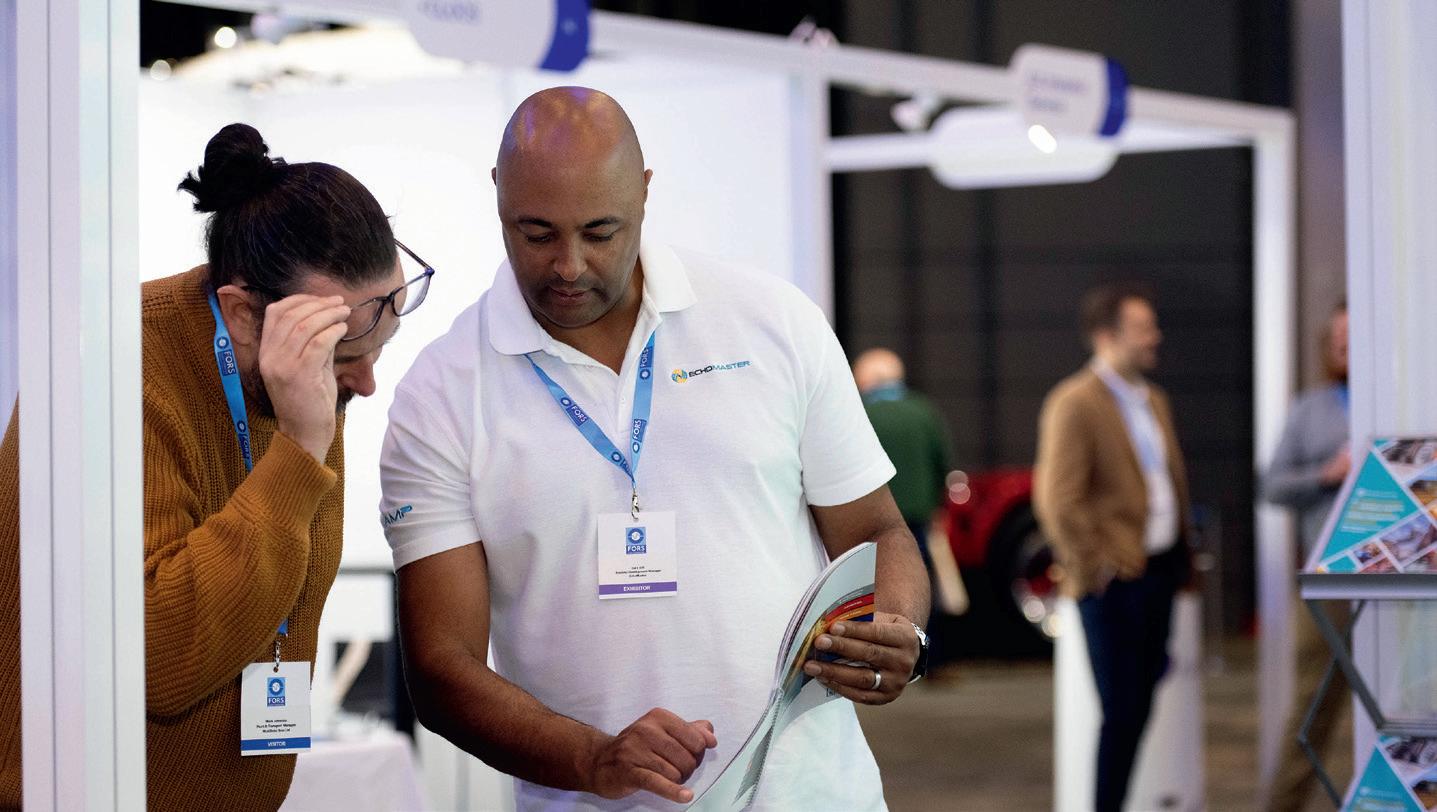
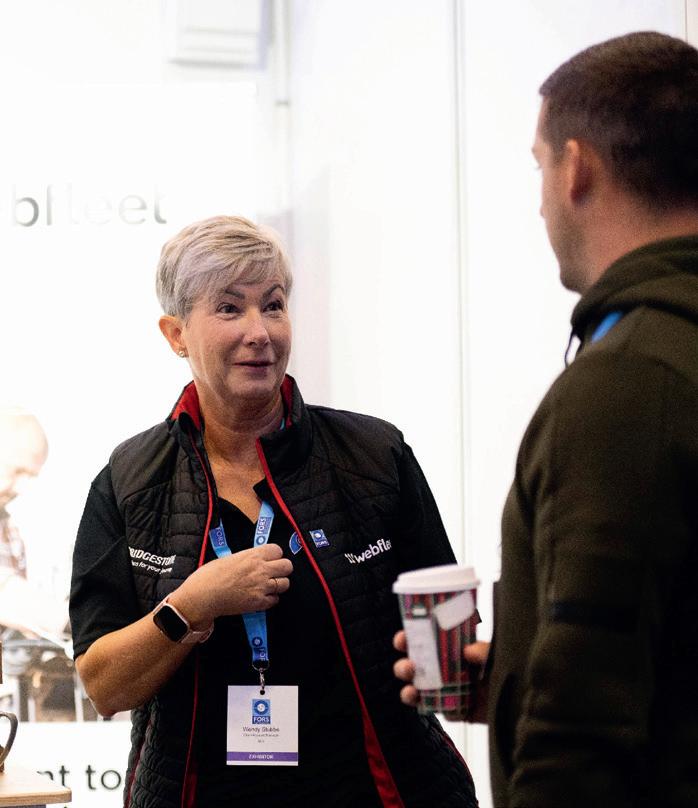




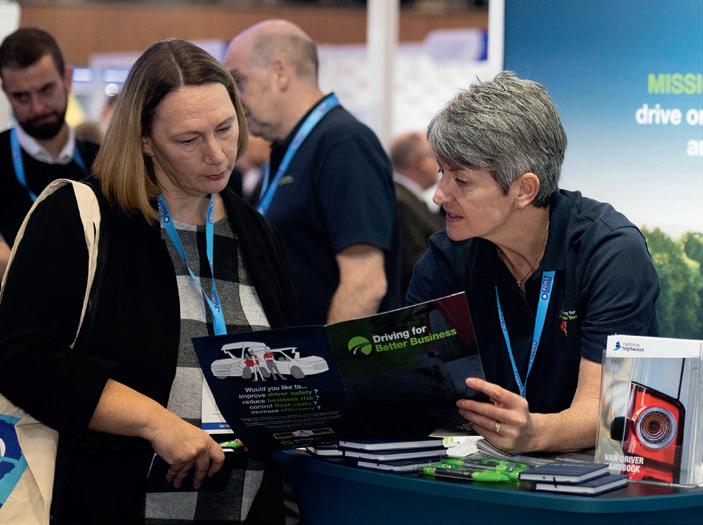
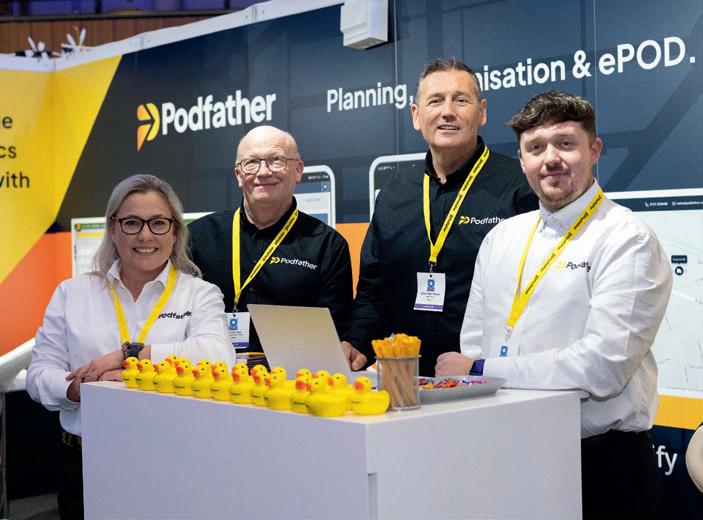
FORS Annual Conference 24 | STANDARD MAGAZINE winter 2023/24




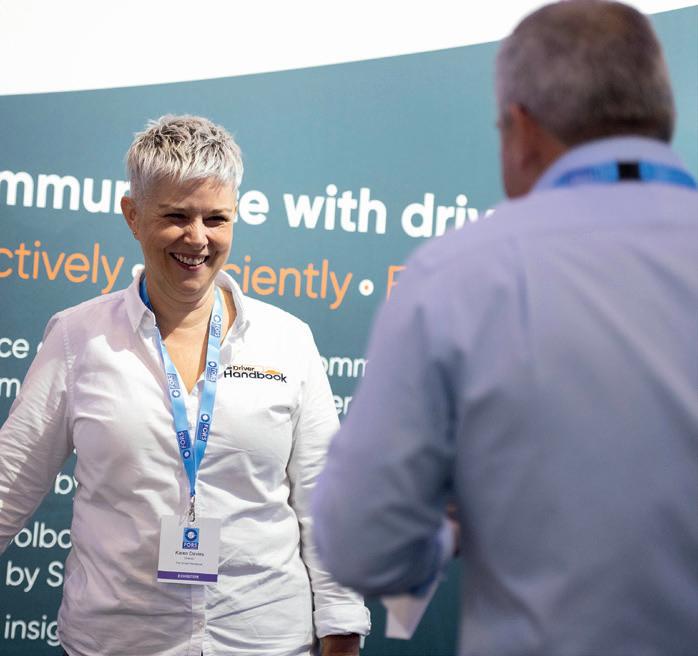




FORS Annual Conference winter 2023/24 STANDARD MAGAZINE | 25
Words: Holly Denton
FORS GOLD OPENS NEW DOORS FOR D.A.W LOGISTICS
An unwavering commitment to high standards leads to success for York-based firm
York-based storage and distribution specialist, D.A.W. Logistics, points to FORS Gold as a key driver of business growth, crediting ongoing FORS accreditation for bringing in six new clients in the past two years.
Since 2015, FORS has played an instrumental role in elevating D.A.W.’s reputation and standards. Dave Wright, managing director and founder, says accreditation is the perfect way to
demonstrate the company’s commitment to operational excellence and provide a distinct competitive edge.
D.A.W. started trading in 1988 when Wright went into business as a single van operator. From these humble beginnings, the company’s customer base – and consequently its fleet – has steadily grown. Wright and his team now operate a small but diverse fleet that includes a range of vehicles, from small vans to 44-tonne artics.

D.A.W operates a small but diverse fleet that includes a range of vehicles, from small vans to 44-tonne artics

According to Wright, the company’s longevity and success can be attributed to an unwavering commitment to high standards in everything it does, from customer relations to driver training.
“We have always strived to differentiate ourselves,” he said. “From the very beginning when I was just a man with a van, I didn’t want to be just another run-of-the-mill general haulier. My goal was to grow the business by specialising in more bespoke services that demand extra attention to detail.”
True to this vision, the modern-day D.A.W. is adept at providing creative solutions to complex delivery challenges, including out-of-hours operations and other unique contracts that feature technical or logistical difficulties.
Operator Profile 26 | STANDARD MAGAZINE winter 2023/24

Aligning with FORS in 2015 felt like a natural step in the company’s evolution. Wright said: “I always felt that FORS would enable us to maintain, or even
customers from further afield than I ever imagined.”
The company’s dedication to excellence is echoed across the entire team and
In the past two years, we’ve won a number of contracts that wouldn’t have been possible without FORS
raise, our standards. It is also a powerful commercial tool – especially when you reach Gold. In the past two years alone, we’ve won a number of contracts that simply wouldn’t have been possible without FORS and we are attracting
staff understand the value FORS brings to the company. Wright ensures that all his drivers and management staff are continuously upskilled, regularly using FORS-based training modules to sharpen their knowledge.
“Training and development are vital to the ongoing success of any business,” he added. “For a small business like D.A.W., the resources and support available from FORS are invaluable.” ◼
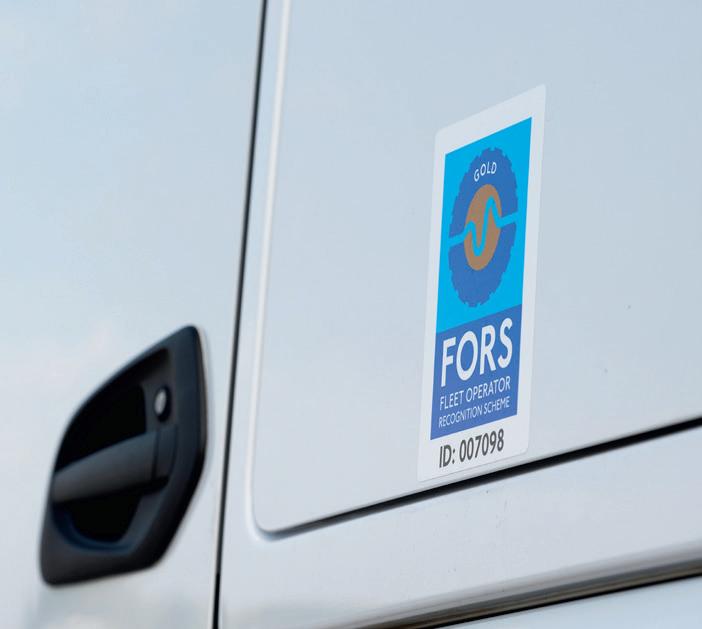
Operator Profile winter 2023/24 STANDARD MAGAZINE | 27
TYRES FOR COLD COMFORT
Cold weather tyres are a wise choice in winter for transport firms.
But some are better for our changeable climate than others
Winters in the UK are generally milder than those of Continental Europe, but cold temperatures can occur at any time from November to April. Indeed, winter often returns with a vengeance in spring: temperatures lower than any recorded in the preceding quarter were measured during the month of March in 2001, 2006 and 2011 as far south as Heathrow Airport. Snow is also quite likely in March and in 2016, the heaviest snowfalls of the year occurred in April, causing significant disruption to transport. In fact, a white Easter is more likely in the British Isles than a white Christmas.
So, maintaining a fleet in a state of winter readiness is not just a task for December and January. Nor is it just for those based in, or travelling to, Scotland or the bleaker parts of mainland Europe. The actual temperature range in England is more extreme than in other parts of the United Kingdom, although Scotland unsurprisingly holds the record for absolute cold, with -27.2C being recorded in the Highlands at Altnaharra in December 2019, and even icy freezing puddles in Lagganlia, Inverness-shire in July, 1973. However, England is not far behind with -26.1C being recorded in January 1982 in Newport, Shropshire.
Wales and Northern Ireland are generally warmer and wetter, but can equally suffer unpredictable weather.
Temperatures at Katesbridge, County Down fell to -14.8C in March 2001, and even in August 2014 a low of -1.9C was recorded at the same place. St Harmon in Powys experienced a freezing -6.2C
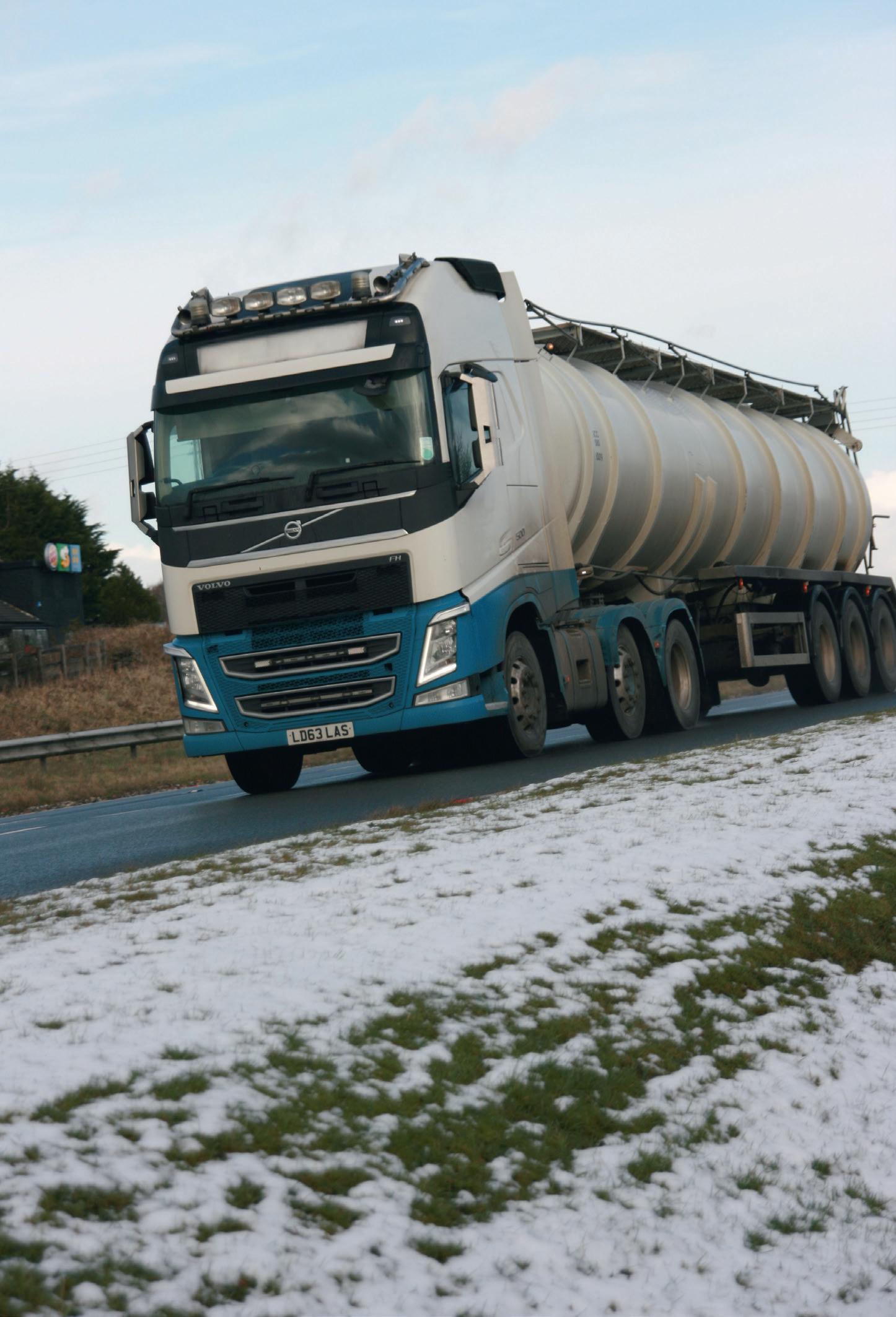
Winter Tyres 28 | STANDARD MAGAZINE winter 2023/24
Right: Rain, snow and ice are all part of a typical British winter
Words: Richard Simpson
in May 2020, while 10 years earlier, November saw -18C recorded in Llysdinam, Powys.
All of which makes the contention that specialist tyres for winter service are not necessary for UK use, or will only come into their own for a couple of days a year, rather a weak one. In fact, it’s possible to encounter snow for more than half the year in most of the UK.
But, equally, there is little point in fitting dedicated tyres that will only perform at their best on ice and snow when statistically the chances are that it won’t snow or freeze on any given day.
Better products
Fortunately, tyre manufacturers now offer products that can cope with a wide range of conditions from icy roads to a warm, wet English summer. But

Tyre

confusingly, there are a number of different ‘cold season’ classifications for tyres.
The oldest-established marking is M + S or MST. This stands for ‘mud and snow’, or ‘multi-service tyre’ and indicates that the tyre is more suitable for use in mud and snow than other tyres in the manufacturer’s range that do not have the marking.
But there is no independent measurement of its performance in winter conditions. In fact, it usually indicates that the tyre has a coarse, aggressive tread pattern that is suited to soft surfaces. Most tipper trucks will, for example, come from the factory fitted with M + S tyres. They do have drawbacks: they tend to generate more road noise than standard-pattern tyres, wear more quickly and have a detrimental effect on fuel consumption, but a truck fitted with them may be able to claw its way out of situations that would defeat a truck on standard road tyres thanks to their superior grip and self-cleaning properties on soft surfaces.
Conversely, their tall and unsupported tread blocks can ‘shuffle’ on hard surfaces, generating less grip than a standard road tyre.
But no matter what the tread pattern, the on-highway performance of tyres starts to deteriorate when ambient temperatures fall below 7C. The complex compounds used to make the tyres tend
Winter Tyres winter 2023/24 STANDARD MAGAZINE | 29
Right: Winter conditions can be encountered on British roads any time from November to April and tyre choice is crucial for safety
manufacturers now offer products that can cope with a wide range of road conditions
to become stiffer and more brittle at this point. This is particularly noticeable in some ‘long-distance’ tyres, which achieve their remarkable savings in fuel consumption by employing hard compounds and stiff carcases. Tyre manufacturers point out that the material and construction of the tyre is actually far more important in suiting it for a particular use than the tread pattern is.
How to judge?
So, how is the buyer to judge how effective a tyre will be in general winter conditions?
The Three-Peak Mountain Snowflake (3PMSF) label category was introduced in 2012. This, also known as the ‘Alpine’ classification, is won by a tyre when it undergoes testing in severe winter conditions against an industry standard ‘reference’ tyre. The test applies to the drive-axle position, although some manufacturers have also achieved it with ‘all-position’ and ‘steer’ tyres.
To win the 3PMSF label, the tested tyre must beat the reference tyre by over 25 per cent in six out of 10 test runs. The test is an acceleration and braking exercise conducted on a flat surface with a 30mm thick base layer of compacted snow covered with a 20mm layer of fresh snow. The ambient temperature must be between -2C and -15C and the snow temperature between 1C and -15C. There is also a new ‘Ice’ category for
Tyre manufacturers now offer products that can cope with a wide range of conditions from icy roads to a warm, wet English summer
tyres, similar to the 3PMSF category, but tested on an ice surface rather than a snow one. Tyres bearing this mark are also known as ‘Nordic’ tyres.
To further confuse things, there are dedicated ‘winter’ tyres that bear the 3PMSF label and feature a compound that

works best at low ambient temperatures but may deteriorate quite rapidly at higher temperatures, and ‘All-seasons’ 3PMSF tyres that may not perform quite so well at very low temperatures as the dedicated ‘winter’ tyres, but also return acceptable performance in summer conditions. Tyres of the latter type will be most suitable for the majority of UK operations.
A further factor to consider is wet braking grip. This is shown on the EU tyre label on a scale of ‘A’ to ‘E’ (the previous ‘F’ and ‘G’ categories having being abandoned), with A being the best performing.
In recent years, leading tyre manufacturers have made great advances in developing tread patterns that expose more gripping features as the tyre wears.
However, the full benefits of 3PMSF tyres are likely to diminish when there is less than 4mm of tread left and operators should consider either removing the tyres until spring and replacing them with fresh covers or getting them regrooved to the approved pattern by a qualified technician. ◼



Winter Tyres 30 | STANDARD MAGAZINE winter 2023/24
Right: 3PMSF sidewall markings (highlighted in orange for illustrative purposes) indicate superior tyre performance in snow


AchieveFORSandPSS compliancewithasingle Fastview360system
PSSisrelevanttovehicles12T+and under3starrated
•Cameramonitoringsystem
•ClassVandVImirrors
•Blindspotinformationsystem(BSIS�
•Movingoffinformationsystem(MOIS�
•Audiblewarningalerts
•Visualwarningsignage
•Sideunder-runprotection
ScantheQRcodeto getyourstarrating


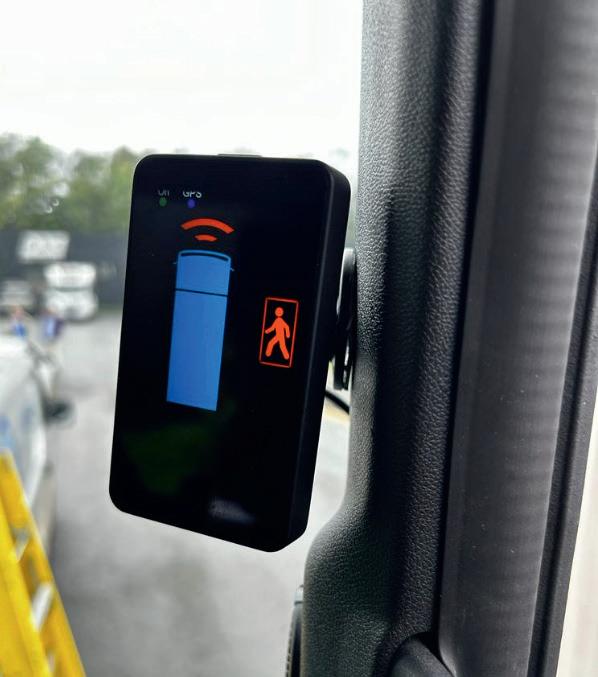



AlreadyFORSAccredited?
BenefitfromourFORS Membershipoffers
Notaccreditedyet? Wecanhelpyouachieveyour FORSAccreditation!



That’s the sound of your company’s reputation hitting another challenge.
But you can manage the risk to your drivers and your business by investing in world-class fleet consultancy, driver assessment and training. Something we’ve been providing to businesses worldwide for over 30 years.
We’re part of the AA too, so we know it makes a real difference to you that your drivers have the knowledge and experience to be the amongst the safest on the road.
It’s important to us because it’s our vision to make our roads safer for everyone. So let’s work together to protect your reputation, reduce costs and save lives.
driver assessment and training
Drivers. Safer Roads.
World-class
Safer
www.drivetech.co.uk/saferdrivers email: tellmemore@drivetech.co.uk 01256 610907

Hercules the Hero of Greek mythology is back!
The Features
• 80mm double bayonet
• External device
• FlexiFlow Unique System
• Advanced Fuel Dissipator
• 6 Year Guarantee
The Journey
Our technical team reviewed all floating ball/valve devices on the market and obtained feedback from customers for all. The answer was simple or so we thought! Design a device that would fit various vehicles, high filling speeds, reliability, durability at the lowest cost. It took over 2 years of testing, development and prototypes before we gave it to a select base of customers to live test on working fleets. We had a winning design, crucially, it could not be siphoned as other floating ball devices. Hercules is back.
FuelDefend Global introduces the Hercules. The world’s only floating ball device designed with a FlexiFlow System, allowing the fuel filler nozzle to go from a vertical filling position for articulated vehicles to 30 degrees for rigid body vehicles, whilst maintaining a flow rate of 110 L/min without splashback or cut-off utilising our Advanced Fuel Dissipator. This is better than anything else on the market today, Hercules is the most cost-effective floating ball device available. ANY


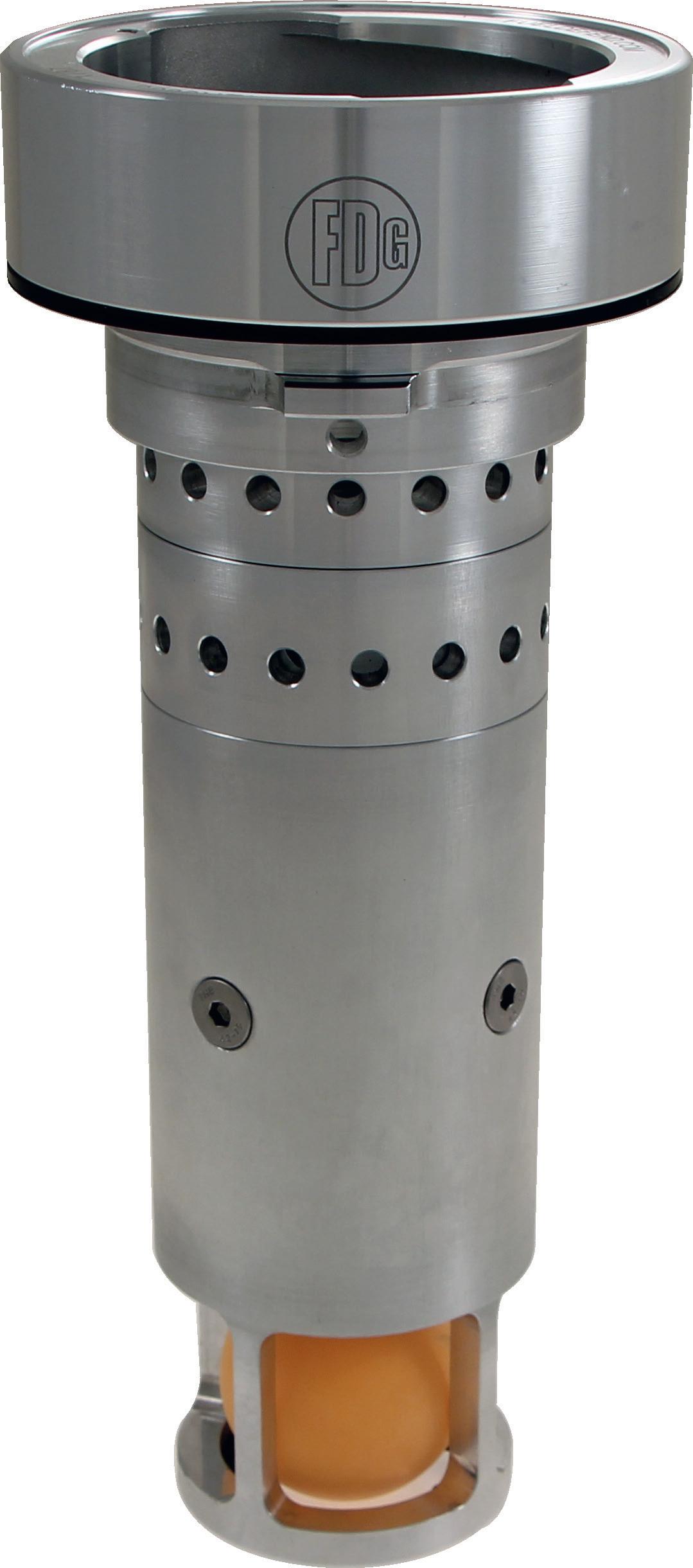



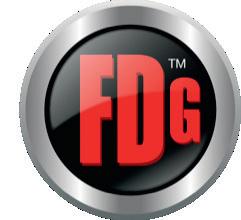
fueldefend.com
CARTON OF 8 HERCULES ASD’S
OFF
USE CODE: Q1HERC15/8 15%
Words: Richard Simpson
COUNTING UP THE ENVIRONMENTAL COSTS
Recording greenhouse gas emissions is probably not top of the to-do list for most fleets, but it is something that should be on the radar of transport firms
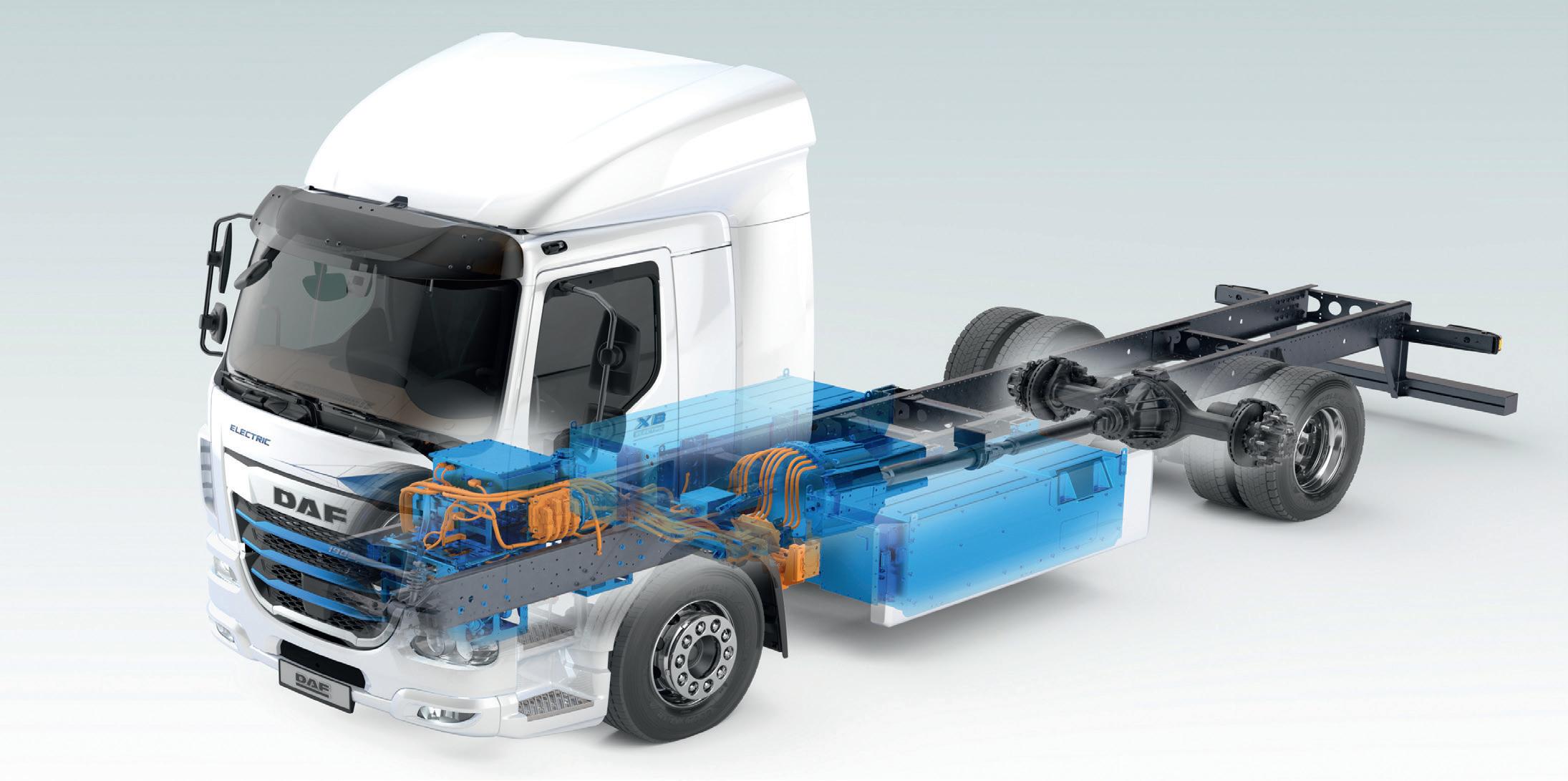
Recording an organisation’s output of greenhouse gases (GHG) may one day become just as routine as filing financial accounts at Companies House, as the UK’s Government seeks compliance with the International Sustainability Standards Board through the GHG Protocol, a body which says it ‘supplies the world’s most widely used greenhouse gas accounting standards’.
GHG Protocol assigns an organisation’s GHG (that includes not only CO2 but methane and other gases) output into one of three categories: Scope 1, 2, and 3.
Scope 1 covers direct emissions from an organisation’s owned or directly controlled sources, while Scope 2 covers
indirect emissions from purchased energy.
So, a company that had premises heated by oil, but lit by electricity, would count the direct emissions from its heating boiler under Scope 1 and the indirect emissions from its use of electricity from the National Grid for lighting under Scope 2.
If that company ran a vehicle fleet, then the GHG released by fuel consumed by internal-combustion-powered vehicles would count under Scope 1, while emissions from the generation of electricity used to charge electric vehicles would count under Scope 2.
At the moment, only the very largest organisations in the UK report their Scope 1 and 2 GHG emissions. But the net
will be cast far wider as Scope 3 emissions come into focus. Scope 3 covers all GHG emissions not included in Scope 2 that are created in the organisation’s value chain.
This includes emissions from suppliers of material and providers of services, including road transport. Therefore, the large organisations will be required to report not only their scope 1 and 2 emissions, but also those of their suppliers and providers.
At the moment, just a few large organisations do this and it is done on a voluntary basis.
But, significantly, the Government is consulting on the cost, benefits and practicalities of casting the Scope 3 net wider. Widening Scope 3 and
Alternative Fuels 34 | STANDARD MAGAZINE winter 2023/24
Above: Using a battery-electric truck will reduce Scope 1 GHG emissions to zero
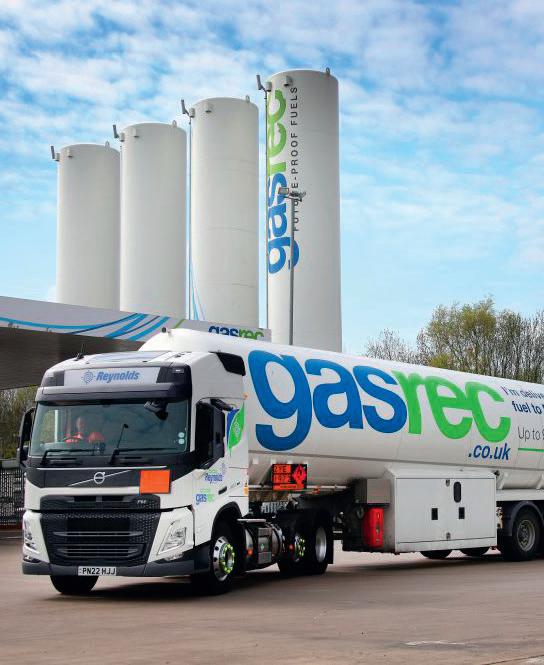
It is an open secret that the Treasury faces a significant gap in its revenue as road users switch from fossil fuel to electric power
Alternative Fuels winter 2023/24 STANDARD MAGAZINE | 35
Switching to biogas-powered vehicles can cut CO2 exhaust emissions by 90 per cent

introducing a level of compulsion would mean that many small and mediumsized enterprises, including transport providers, would find their work for companies reporting GHG emissions falling into Scope 3. This would oblige them to record at least some of their own Scope 1 and 2 emissions.
Why is this happening?
The official Government line is: “The framework aims to increase awareness of energy costs and emissions within organisations by providing them with data to inform the adoption of energy efficiency measures and help them to reduce their impact on climate change. It also aims to provide greater transparency and consistency of disclosures for investors and stakeholders to enable them to hold businesses to account.” This sounds harmless enough. However, it is an open secret that the Treasury faces a significant and growing gap in its revenue as road users switch from fossil fuel to electric power. The UK’s Office for Budget Responsibility expects fuel duty from petrol and diesel
to drop from £35bn to £24.3bn in revenue for the Government in the current financial year. This will have to be made up for by imposing other taxes.
It can easily be argued that it would be fair to phase out reliance upon fuel duty on petrol and diesel as use of these fuels declines and impose it instead on the output of greenhouse gases. The only problem is calculating and accounting for all the greenhouse gases emitted, which will be a complex issue given that some Scope 2 and 3 emissions that may even be produced abroad in nations which may or may not have taxed them already anyway.
Some aspects of GHG production are easily calculated. For instance, a litre of diesel burned produces 2,460 grams of CO2. This figure is reached by first establishing the mass of a litre of diesel: 845 grams. Diesel is 82.6 per cent carbon, so there is 720 grams of carbon in a litre of diesel. Converting this carbon into CO2 will take 1920 grams of atmospheric oxygen. So, we add 720 to 1920 and arrive at 2640. Simple!
So, that’s the Scope 1 emissions from diesel sorted. But Scope 2 and 3 have still to be added. That will include the CO2
emitted during oil exploration, extraction, transportation, refining, and delivery.
Opportunities and threats
We can expect to hear more and more about the recording of Scope 1, 2 and 3 GHG emissions. This is both a threat and an opportunity for small and medium-sized transport firms. GHG emissions recording is being introduced from the ‘top down’ and large enterprises will no doubt be challenging their transport contractors to reduce their own Scope 1 emissions so the large enterprise can record lower Scope 3 emissions.
This provides an opportunity to demand premium prices for lower emissions – whether this be using more expensive biofuels such as HVO in existing vehicles, or switching to alternative fuels such biogas, or replacing ICE vehicles with batteryelectrics. For the first time, large organisations will have a real incentive to help their transport suppliers invest in low-carbon technology. It will be interesting to see how they react. ■
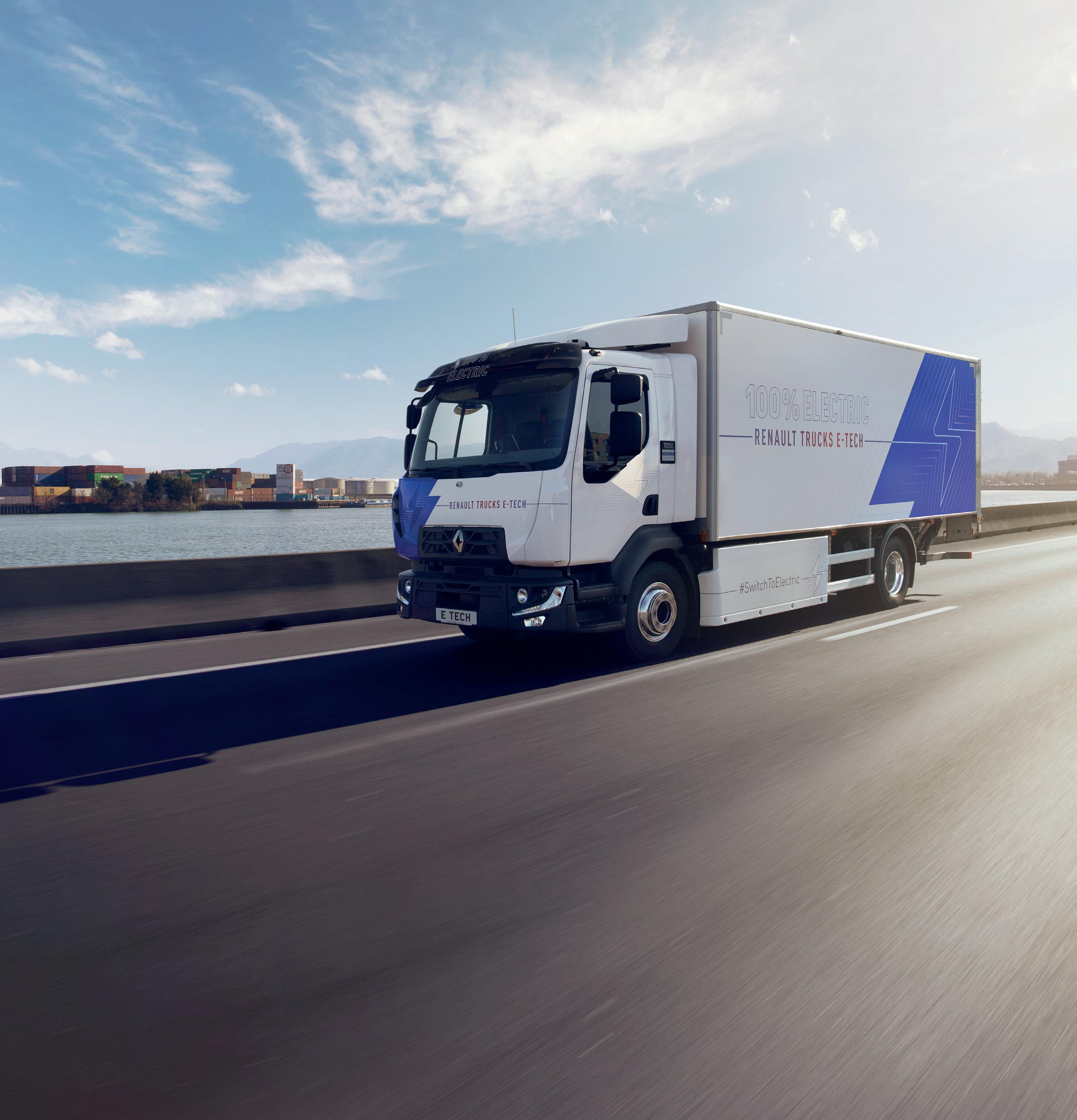
Alternative Fuels 36 | STANDARD MAGAZINE winter 2023/24
Above: How green was my valley: Drax now burns renewable biofuels, not coal, to produce electricity

100% electric
RENAULT TRUCKS E-TECH
At Renault Trucks we are pioneers in electric vehicles. Our experience, and that of our expert partners, can help you introduce electric vehicles to your fleet, and reduce CO2 emissions to the benefit of us all.
renault-trucks.co.uk
winter 2023/24 STANDARD MAGAZINE | 37
Words: Matthew Eisenegger
JCB USES HYDROGEN ON ITS ROAD TO NET ZERO
Heavy hitter says pure electric power just won’t work for some of its products
While battery electric powertrains have become the driveline of choice for many passenger car, light commercial and even some truck manufacturers as they head towards a zero carbon future, there are plenty of companies looking at alternatives to pure electric power. Battery electric works well on smaller equipment, but there are limits to its effectiveness as weights and distances grow.
Hydrogen has been offered as one alternative by a number of companies, most notably Toyota in its Mirai passenger car, which is now donating its fuel cell driveline to the Hilux pickup. Fuel cells have also been proven in heavier equipment, including trucks and construction excavators from manufacturers like Hyundai.
However, the fuel cell, which combines hydrogen with oxygen to create electricity, producing water vapour as the only emission, does have its limitations.
Fuel cells are expensive and relatively delicate, particularly when considering heavy duty applications in construction and agricultural equipment.
A potential solution is using hydrogen
as a fuel to power a combustion engine, rather than a fuel cell stack. If similar power and torque outputs can be created from a hydrogen-fuelled engine, then it can use existing transmission and hydraulic pump technology to power the machine.
Construction demand
That is the approach being taken by the UK’s biggest construction equipment manufacturer, JCB. The Staffordshirebased global company has been building its own range of four and six-cylinder diesel engines for some years, both to power its in-house range of machinery and to market to other equipment providers as a third-party power source.
In what JCB calls its ‘Off-Road to Zero’, the company has been working on a range of alternatives to diesel. It was among the first construction equipment firms to launch a commercially available full electric mini excavator and this has been joined by electric compact wheeled loaders, telescopic handlers and a range of access platforms that run on battery power alone.
But JCB believes that batteries stop being an effective solution once its equipment gets above around eight-

This is a giant leap forward for JCB and the rest of the world, because we all have one goal, to reduce emissions
Alternative Fuel 38 | STANDARD MAGAZINE winter 2023/24
Above: A mobile hydrogen refueller joins the gas-powered JCB Loadall and backhoe
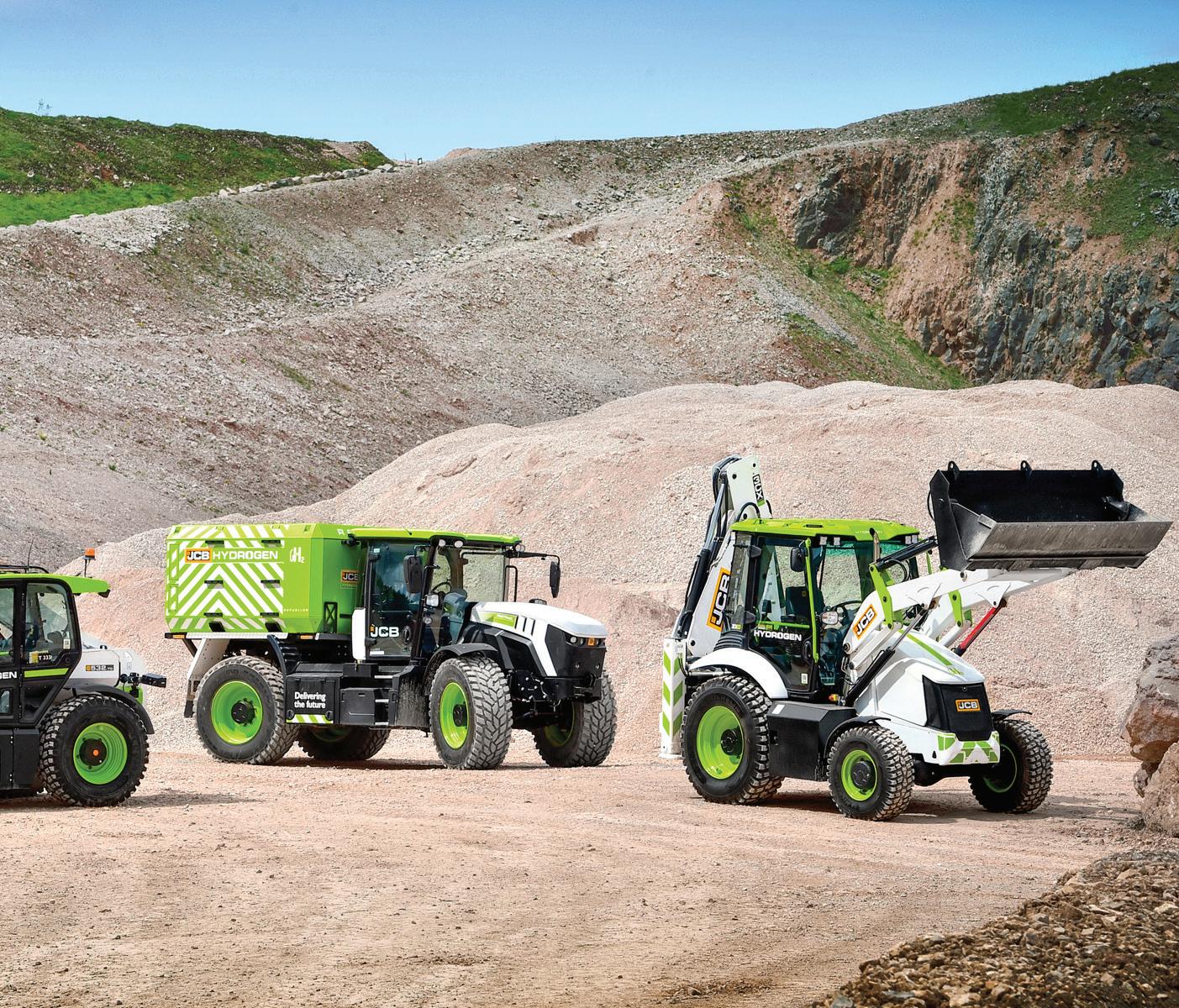
tonnes operating weight. This is not only because the number and size of batteries required for larger machinery would be hugely expensive and heavy, but also has to do with the charging infrastructure.
Tasked to develop a hydrogen-burning engine that would offer the same power and torque as the diesel models
On a construction site, it is relatively easy to bring smaller mini excavators and loaders back to a compound during the lunch break or in the evening to charge. As the machinery gets bigger though, the fuel needs to be taken to the machine, rather than bringing the machine to the refuelling point. With a mobile on-site refuelling system, JCB believes that the hydrogen engine offers a level of operating autonomy that customers can work with. Having trialled a fuel
cell in a 20-tonne excavator, in mid2022 company chairman Lord Anthony Bamford set the engineering team at the Derby engine plant a challenge. He tasked them to develop a hydrogen burning engine that would offer the same power and torque as the diesel models, would require similar service intervals and would take up a similar physical space within the machinery, making it easy to adopt.
With a budget of £100m, around 150 engineers set to the task, creating more than 50 prototype engines before settling on a marketable design. The result is a hydrogen engine that was launched at the Conexpo construction equipment
Alternative Fuel winter 2023/24 STANDARD MAGAZINE | 39

exhibition in early 2023 in Las Vegas.
Lord Bamford said: “The unique combustion properties of hydrogen enable the hydrogen engine to deliver the same power, the same torque and the same efficiency that powers JCB machines today, but in a zero-carbon way.
“By leveraging diesel engine technology and components, they do not require rare earth elements and critically, combustion technology is already well proven on construction and agricultural equipment. It is technology which is cost-effective, robust, reliable and well known throughout not just the construction and agricultural industry, but the whole world.”
To prove the viability of the hydrogen engine, JCB has installed the motor in a range of its mid-weight equipment, in a Mercedes-Benz Atego 7.5-tonne truck and in a Sprinter van, showing that the engine’s characteristics will work in a road-going vehicle as well as in off-road applications.
“This is a giant leap forward for JCB and the rest of the world, because we all have one goal, to reduce emissions,” said Lord Bamford.
“The hydrogen engine we have installed in the truck is the same as those already
powering prototype JCB machines, so there is no reason we should not see hydrogen combustion engines in vehicles used on the roads in the future, including cars.”
The JCB hydrogen design
The hydrogen engine block has much in common with JCB’s four-cylinder 444 diesel engine, though the hydrogen unit gets a completely new cylinder head and a combustion system with far lower injection pressures than its diesel counterpart. This allows it to be built on the same line as the diesel variants in both of the company’s engine plants. Spark plugs are used to ignite the fuel air mix and the engine uses a much larger turbocharger, to increase compression of the incoming air.
“It is a totally new engine, not a conversion,” said Ryan Ballard, engineering director at JCB Power Systems. “Lots of people have tried to do a hydrogen engine, but the problem has been that it’s always been a conversion.” JCB’s engine plants in Derbyshire and India currently produce 400 engines a day between them and the plan is that the hydrogen engines should be built alongside existing and future diesel

Alternative Fuel 40 | STANDARD MAGAZINE winter 2023/24
Below: JCB has invested £100m in developing its new hydrogen-powered engines
Above: JCB’s new powerplant, which is now fuelled by hydrogen gas

Lots of people have tried to do a hydrogen engine, but the problem has been that it’s always been a conversion

models. To meet this requirement, five of JCB’s dynamometer test cells now operate hydrogen engines, rather than diesel-powered motors and hydrogen test engines are rolling off the line. The company has already produced prototype hydrogen versions of its popular 3CX backhoe loader, its mid-range telescopic handlers and its Fastrac high-speed agricultural tractors.
Hydrogen distribution
If it is difficult to recharge a battery electric machine on a construction site, then having a ready supply of hydrogen could be equally problematic. To combat this, JCB has been working on a refuelling solution in tandem with its hydrogen engine development. The gas is delivered in tube trailers that can be left on the
site, with hydrogen stored on-board. The fuel is transferred to a converted Fastrac tractor, which is also powered by the hydrogen engine. This has its own set of hydrogen cylinders mounted on the back, capable of carrying around 100kg of hydrogen, with a refuelling rate of around 1kg/min. The refueller can travel around the site, much like a diesel bowser does today, delivering fuel to each machine in turn.
When running on hydrogen, JCB’s 3CX backhoe loader has tanks that can hold 8-10kg of hydrogen, enough for a full day’s working. These take up no more space on machines than conventional diesel tanks. The refueller can top up those tanks in six to seven minutes, much like a diesel bowser filling a conventional machine. ◼
Alternative Fuel winter 2023/24 STANDARD MAGAZINE | 41
Below: JCB believes that hydrogen power is the way forward to its goal of zero emissions
Above: Vehicles can be topped up on site using this Fastrac tractor
STUDY PROVES UPCYCLED REFUSE TRUCKS ARE THE GREENEST OF ALL
Lunaz models even beat fully electric equivalents Words:
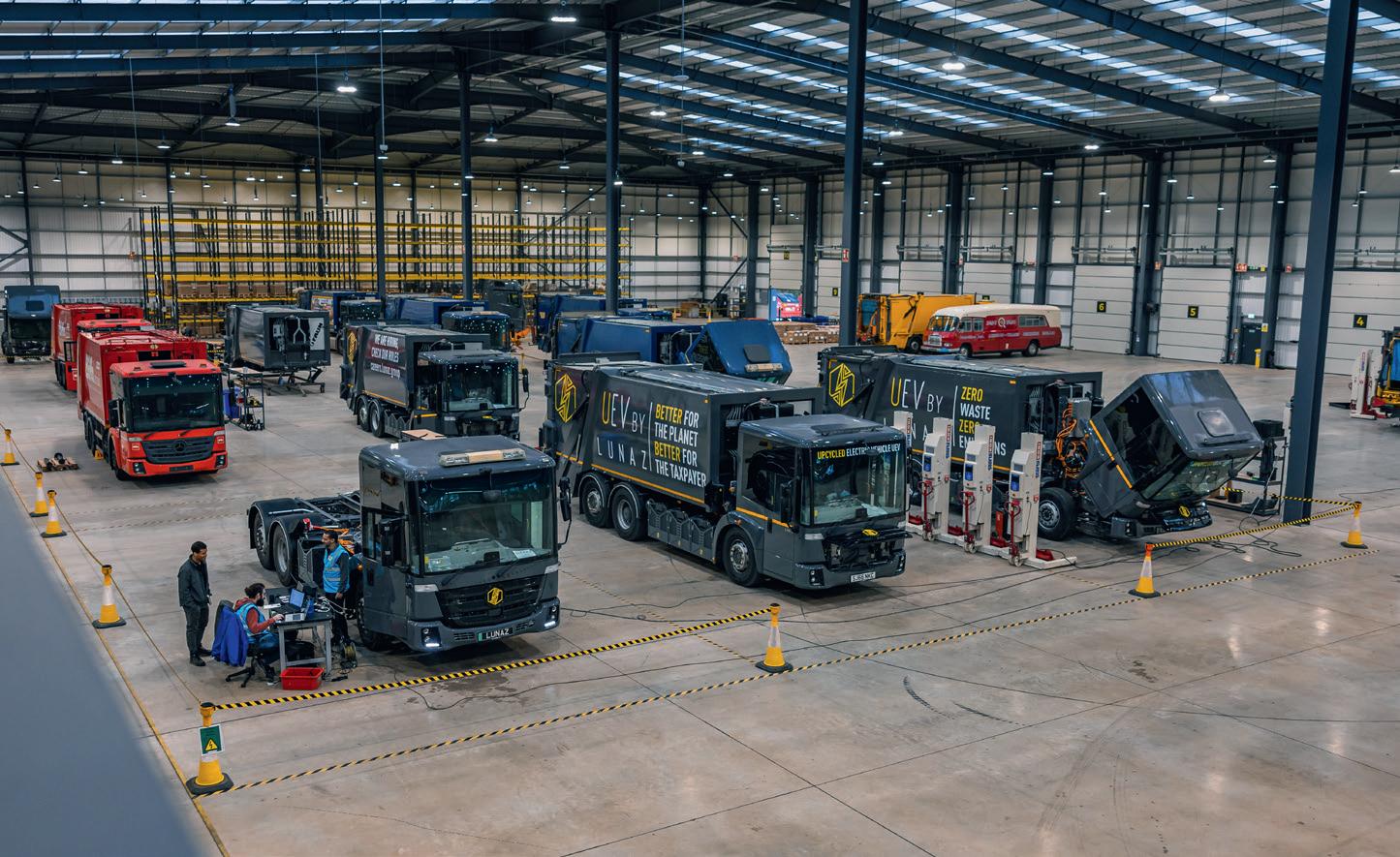
ALunaz upcycled electric vehicle refuse collection truck saves 344 tonnes of carbon dioxide emissions compared to a new diesel equivalent, according to an independent study commissioned by the company. This is the equivalent of 245 flights from London to Los Angeles, or the weight of two 400-seat transatlantic commercial aircraft.
The Lifecycle Carbon Analysis (LCA), conducted by sustainability consultant Tunley Environmental, also found that a Lunaz vehicle saves 43 tonnes of CO2 when compared to a new all-electric model. This is equivalent to more than 30 London to Los Angeles commercial flights, or the weight of 13 private jets. The study identified and quantified all sources of carbon emissions of a refuse truck. This includes the production, installation, use and end-of-life treatment of a Mercedes-Benz Econic refuse vehicle upcycled and electrified
by Lunaz. It then compared it to the figures for conventional diesel and allnew electric versions of the same vehicle.
In the Lunaz upcycling process, endof-life diesel refuse trucks undergo a bare-metal restoration. The engines and associated systems are removed, recycled
The extent of these savings is clearly impactful and a fantastic validation of our technology and approach
and replaced with Lunaz’ fully electric powertrains. Interiors are remodelled with upgraded ergonomics, materials and technology, improving safety and operator wellbeing.
However, upcycling not only gives a second life to diesel refuse trucks – after seven years, Lunaz will take the vehicles back and refurbish them again, with a third refurbishment possible seven years after that. The study, therefore, looks at the total CO2 emissions over three seven-year operating lifetimes. This is supported by a recent partnership with UK-based Altilium, in which a low carbon logistical solution is being developed for the safe transportation and discharging of end-of-life electric vehicle (EV) batteries.
Preserving the embedded carbon in the raw materials and initial manufacturing emissions up to the point where the vehicle enters service – known as ‘cradle-to-gate’ emissions – is where Lunaz offers such sustainability benefits compared to all-new models.
Lunaz founder David Lorenz said: “At a time when investment in sustainable technologies and solutions, especially around transport, is front and centre in the news and legislation, this report is a huge vote of confidence not just in our upcycling process, but in electric propulsion generally.
“This rigorous independent study shows our upcycled electric vehicles’ carbon emissions over their potential lifetime are substantially lower than their new diesel and electric equivalents. The extent of these savings is clearly impactful and a fantastic validation of our technology and approach, providing a clear path to value for our customers and sending strong signals to green technology investors who continue to be attracted to the Lunaz proposition.” ◼
Upcycling 42 | STANDARD MAGAZINE winter 2023/24
Trevor Gehlcken
Left: Old diesel-powered refuse vehicles are upcycled by Lunaz with new electric powertrains
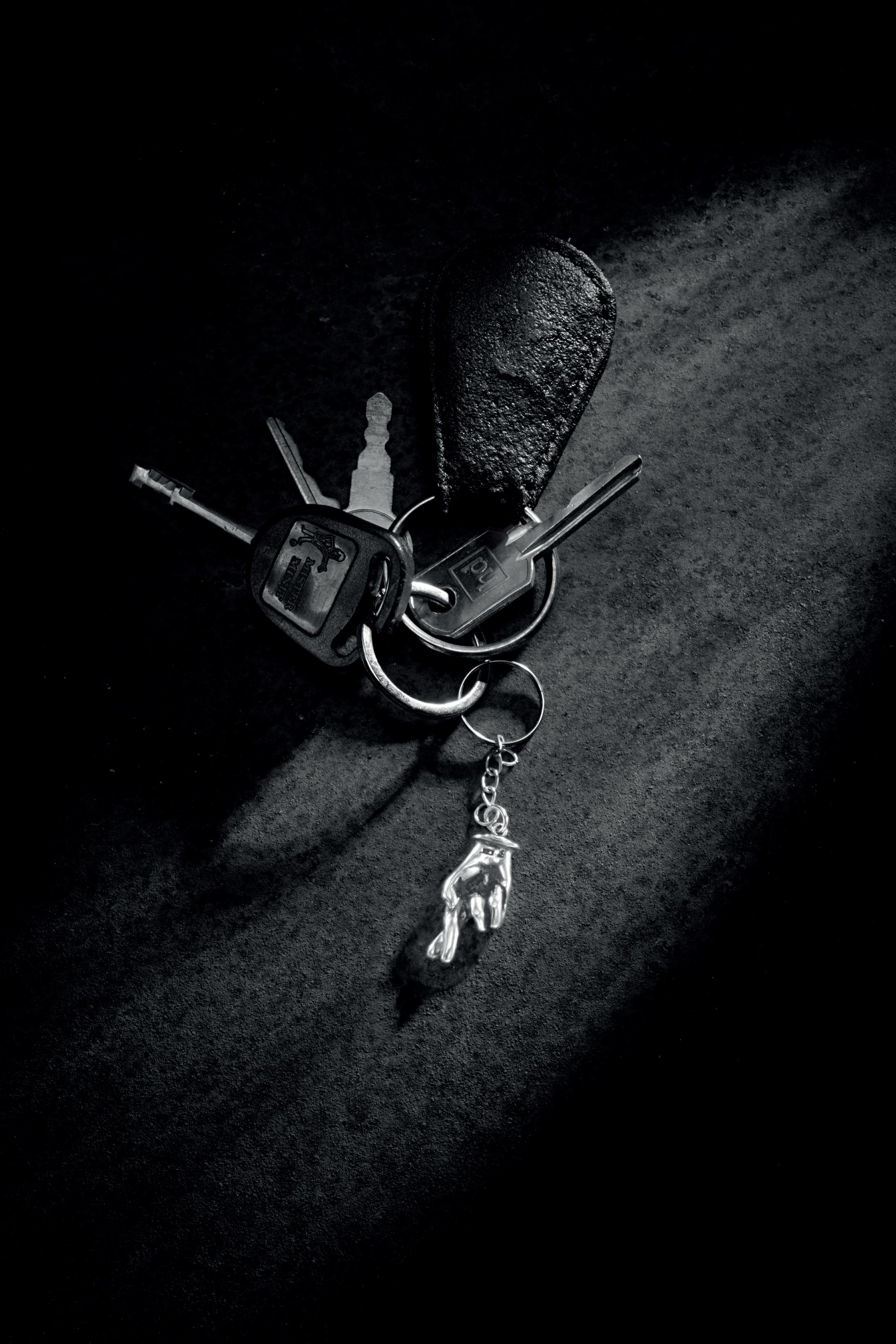
We don’t believe in i t.




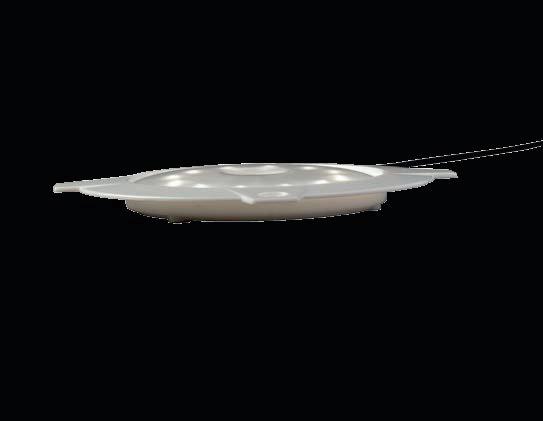
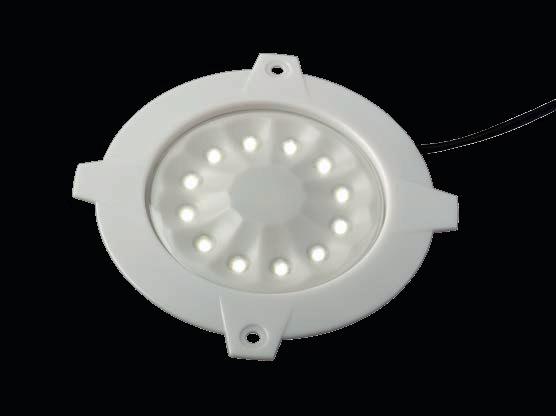






EUROPE’S LARGEST REVERSING & SAFETY EQUIPMENT MANUFACTURER

Classified 44 | STANDARD MAGAZINE winter 2023/24 Amber Valley Developments LLP, 12 Churchill Way,Fleckney • Leicestershire LE8 8UD +44 (0)116 240 2941 Email: sales@amber-valley.co.uk Patented non dazzle batwing style optics • E13 10R-05 15428 Own branding available M.O.Q applies 3 year warranty IP69K ingress protection • Laser marked
RECESSED
Patented non dazzle batwing style optics Patent GB2586468 Applied For Own branding available M.O.Q applies IP69K ingress protection Lumen P.I.R Timed 1269 ✓ 5 mins AVIL1R 1269 AVIL3PIR 339 ✓ 5 mins AVIL3R 339 AVIL5PIR 550 ✓ 5 mins AVIL5R 550 ULTRA LOW PROFILE Height without P.I.R 4.5mm Height with P.I.R 111mm RECESSED MOUNTED INTERIOR LIGHTS Patented non dazzle batwing style optics Patent GB2586468 Applied For Own branding available M.O.Q applies WITH PIR WITHOUT PIR Part No. Lumen AVIL1PIR 1269 AVIL1R 1269 AVIL3PIR 339 ✓ 5 mins AVIL3R 339 AVIL5PIR 550 ✓ 5 mins AVIL5R 550 AVIL7PIR 662 ✓ 5 mins AVIL7R 662 AVIL9PIR 971 ✓ 5 mins AVIL9R 971 ULTRA LOW PROFILE Height without P.I.R 4.5mm Height with P.I.R 4.5mm
be own branded with
moulded into housing
111mm WITHOUT PIR WITH PIR EUROPE’S European Head Amber Valley 12 Churchill Way Fleckney • Leicestershire Tel: +44 Fax: +44 Email: sales@amber-valley.co.uk Website: www.amber-valley.co.uk Part AVIL1PIR AVIL1R AVIL3PIR AVIL3R AVIL5PIR AVIL5R AVIL7PIR AVIL7R AVIL9PIR AVIL9R ULTRA
Height without P.I.R 4.5mm Height with P.I.R 4.5mm
be own branded with logo moulded into housing
111mm
RECESSED MOUNTED INTERIOR LIGHTS
MOUNTED INTERIOR LIGHTS
Can
logo
M.O.Q applies
LOW PROFILE
Can
M.O.Q applies





Don’t rely on chance. Prepare. Prevent. Protect.


Vehicle alcohol ignition interlock device from Dräger



The Interlock® 7500 device from Dräger is designed to prevent drivers from driving under the influence of alcohol. It disables the vehicle if levels of alcohol are detected that are higher than the legal limit and has facial recognition too. Protecting drivers, the public and your reputation. draeger.com
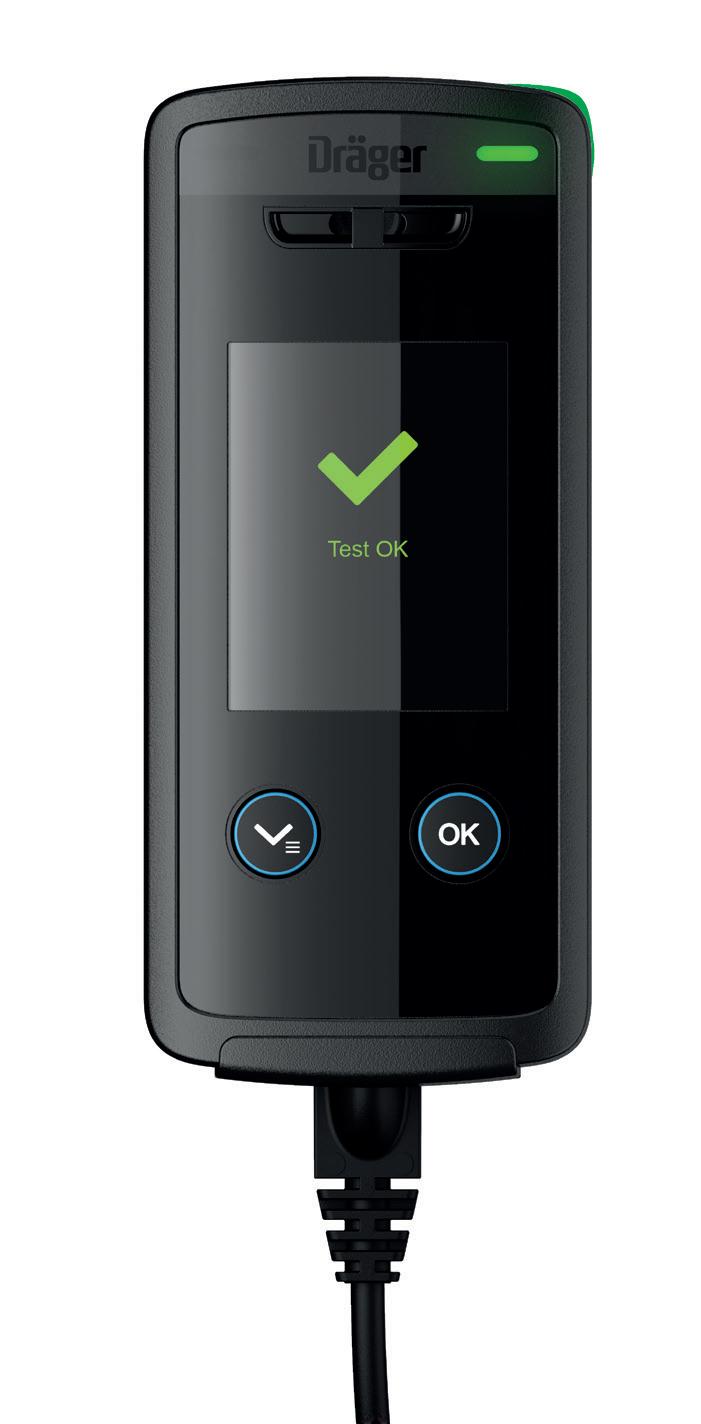
Classified

YOUR WINDOW INTO THE FUTURE
Scania’s vehicles are taking a leap forward. Powered by the premium digital Smart Dash, working seamlessly with a new high-performance computing and communications technology.
Harness advanced safety features, connected maps, customisable digital services, remote diagnostics, over-the-air updates, advanced safety features and more.
This is the Scania Street Smart revolution.

MORE ABOUT SCANIA’S COMPLETE SOLUTIONS AT SCANIA.CO.UK
FLEXIBLE MAINTENANCE GENUINE PARTS SCANIA ASSISTANCE RENTAL FINANCE CONNECTED SERVICES
CONNECTED
LEARN



Order today our latest High Definition Camera Systems meeting the FORS Silver & Gold Standard. Our system kits are packed with up to date technology equipment and can be fitted by our experienced trained technicians at your location.
Why not enhance your system to add all round vision cameras and video recording together with iCloud hosted Sentry Live View for instantaneous camera pictures.
Leading the way in protecting vulnerable road users


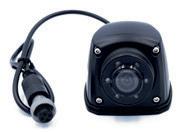






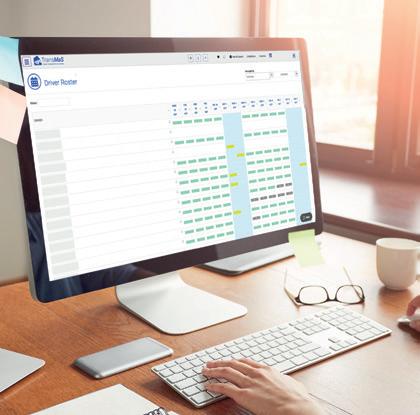


BLIND SPOT REVERSE ALARM REVERSE CAMERA LEFT TURN ALARM SIDE CAMERA FRONT CORNER SCAN MONITOR Contact our sales team on: T: 01285 771333 E: sales@sentinelsystems.co.uk www.sentinelsystems.co.uk Simple, Efficient, Modern Transport Software Solutions • Tachograph Analysis • Vehicle Defect Reporting App • Transport Management System • Automatic Licence Verification • Remote Tachograph Downloads Proud to be the FORS Tacho Service Provider Telephone: 01246 252375 | Email: hello@tdi.tc | Website: tdisoftware.co.uk Take the hassle out of compliance with TDi Software Classified winter 2023/24 STANDARD MAGAZINE | 47
ID:A00264
Words: Trevor Gehlcken
MERC’S NEW eACTROS IN FOR THE LONG HAUL
German manufacturer’s first electric long-distance model revealed
Mercedes-Benz has unveiled the series version of the first battery-electric long-haul truck with a three-pointed star. The manufacturer presented the MercedesBenz eActros 600 at a world premiere to an international audience in Hamburg. With this heavy-duty electric truck, the manufacturer plans to define the new standard in road freight transport – in terms of technology, sustainability, design and profitability for e-fleet operators.
The high battery capacity of more than 600 kilowatt hours – hence the model designation 600 – and a new, efficient electric drive axle developed in-house, enable the e-truck to achieve a range of 620 miles per day.
This is made possible by intermediate charging during legally prescribed driver breaks – even without megawatt charging. Around 60 per cent of long-distance journeys of Mercedes-Benz Trucks customers in Europe are shorter than 310 miles anyway, which

means charging infrastructure at the depot and at loading and unloading points is sufficient in such cases.
For all other uses, continual expansion of public charging infrastructure is vital in order to make the electric truck viable for long-distance haulage across Europe.
In addition to the combined charging system (CCS) with up to 400 kW, the eActros 600 will later also enable megawatt charging (MCS). From the start of sales, customers can order a pre-installation for this. As soon as MCS technology becomes available and is standardised across manufacturers, it is planned to be retrofittable for these models of the eActros 600.
The batteries can be charged from 20 to 80 per cent in about 30 minutes at a suitable charging station with an output of one megawatt.
The vehicle is technically designed for a gross combination weight of up to 44 tonnes. With a standard semitrailer, the eActros 600 has a payload of around 22 tonnes in the EU. In some cases, national law may permit a higher payload.
New Launch 48 | STANDARD MAGAZINE winter 2023/24

In addition to the tractor unit, Mercedes-Benz Trucks will also produce rigid variants of the eActros 600 right from market launch
New Launch winter 2023/24 STANDARD MAGAZINE | 49
Fresh new looks
Visually, the e-truck is characterised by a fundamentally new, puristic design with clear lines and an aerodynamic shape. When it comes to profitability for fleet operators, the electric truck is intended to set new standards, over the long term replacing the majority of diesel trucks in the long-haul transport segment. The core of Mercedes-Benz Trucks’ concept for battery-electric long-distance transport is to offer customers a holistic solution consisting of vehicle technology, consulting, charging infrastructure and services.
Sales of the electric truck start this year. The start of series production is planned for the end of 2024. In addition to the tractor unit, Mercedes-Benz Trucks will also produce rigid variants of the eActros 600 right from market launch, offering customers further possible applications for all-electric transport. A fleet of around 50 prototype vehicles is currently being built, some of which are also to be put into practical testing with customers in the near future.
Cost parity
The time period within which fleet operators can achieve cost parity with a comparable diesel truck using the eActros 600 in long-distance haulage differs from country to country, in particular depending on electricity and diesel prices and toll systems. In the large transit countries of France and Germany, for example, a low electricity price and the planned CO2-based truck toll, respectively, have a positive effect on the operational costs of batteryelectric trucks. This means that the eActros 600 can be more profitable than a diesel long-haul truck within the average vehicle holding period of around five years, or after around 600,000 kilometres – despite a purchase price that is two to two-and-a-half times higher than the diesel equivalent. Government subsidisation of e-trucks and charging infrastructure is a key lever providing support in ramping up the market. A full suite of finance products is available from Daimler Truck Financial Services UK.
More than 80 per cent CO2 savings
The CO2 footprint of the eActros 600 depends heavily on the electricity mix used for driving operation. With the current European energy mix, the eActros 600 achieves CO2 savings
of around 40 per cent compared to a comparable diesel Actros and, with fully renewable energies, of more than 80 per cent over the entire product lifecycle of 10 years from raw material extraction. This corresponds to savings of around 370 or 775 tonnes of CO2. As a result, the eActros 600 can compensate for a higher CO2 footprint ex-works due to its batteries within its first or second year of operation in long-haul transport.
The eActros 600 has three battery packs, each with 207 kWh. These offer an installed total capacity of 621 kWh. The batteries are based on lithium iron phosphate cell technology (LFP) and are characterised by a long service life. Development engineers at MercedesBenz Trucks have designed the eActros 600 to meet the same requirements on the durability of the vehicle and its components as a comparable conventional heavy-duty long-haul Actros.
That means up to 1.2 million kilometres in 10 years of operation. After this period of use, the battery state of health should still be over 80 per cent. Moreover, in contrast to other battery cell technologies, around 95 per cent of the installed capacity can be used with lithium iron phosphate technology. This makes a higher range with the same installed battery capacity possible.
Engineers have developed a new 800-volt electric axle with two electric motors and a four-speed transmission specifically for use in heavy-duty longhaul transport. The electric motors generate a continuous output of 400 kW as well as a peak output of 600 kW and ensure powerful acceleration,
high driving comfort and high driving dynamics. The full motor output is available most of the time with no interruption in torque.
In addition, with a careful driving style, electrical energy can be recovered through recuperation, which is fed back into the batteries of the eActros 600 and is then available again for the drive system. ◼
Below: The start of series production is planned for the end of 2024.


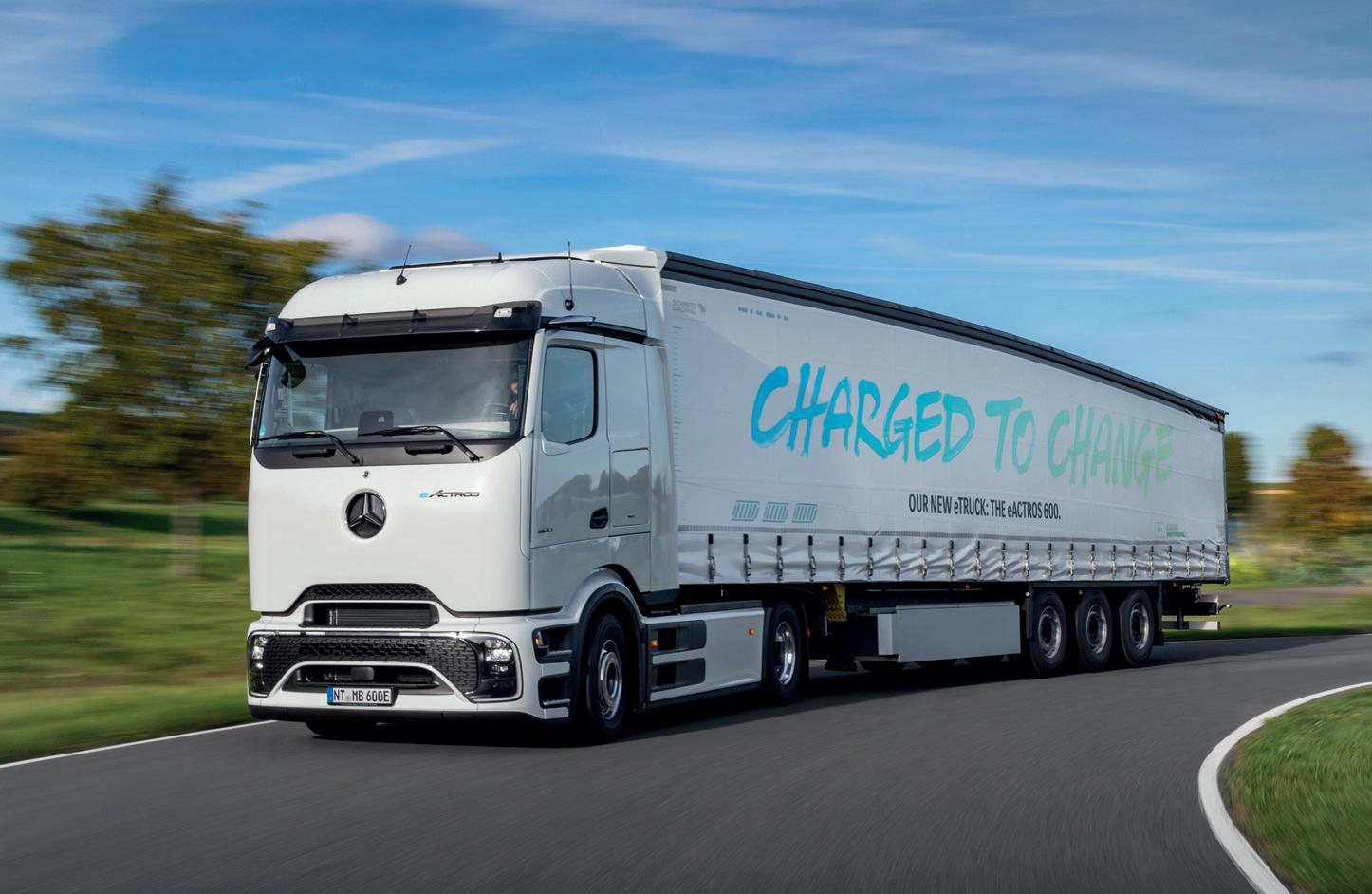

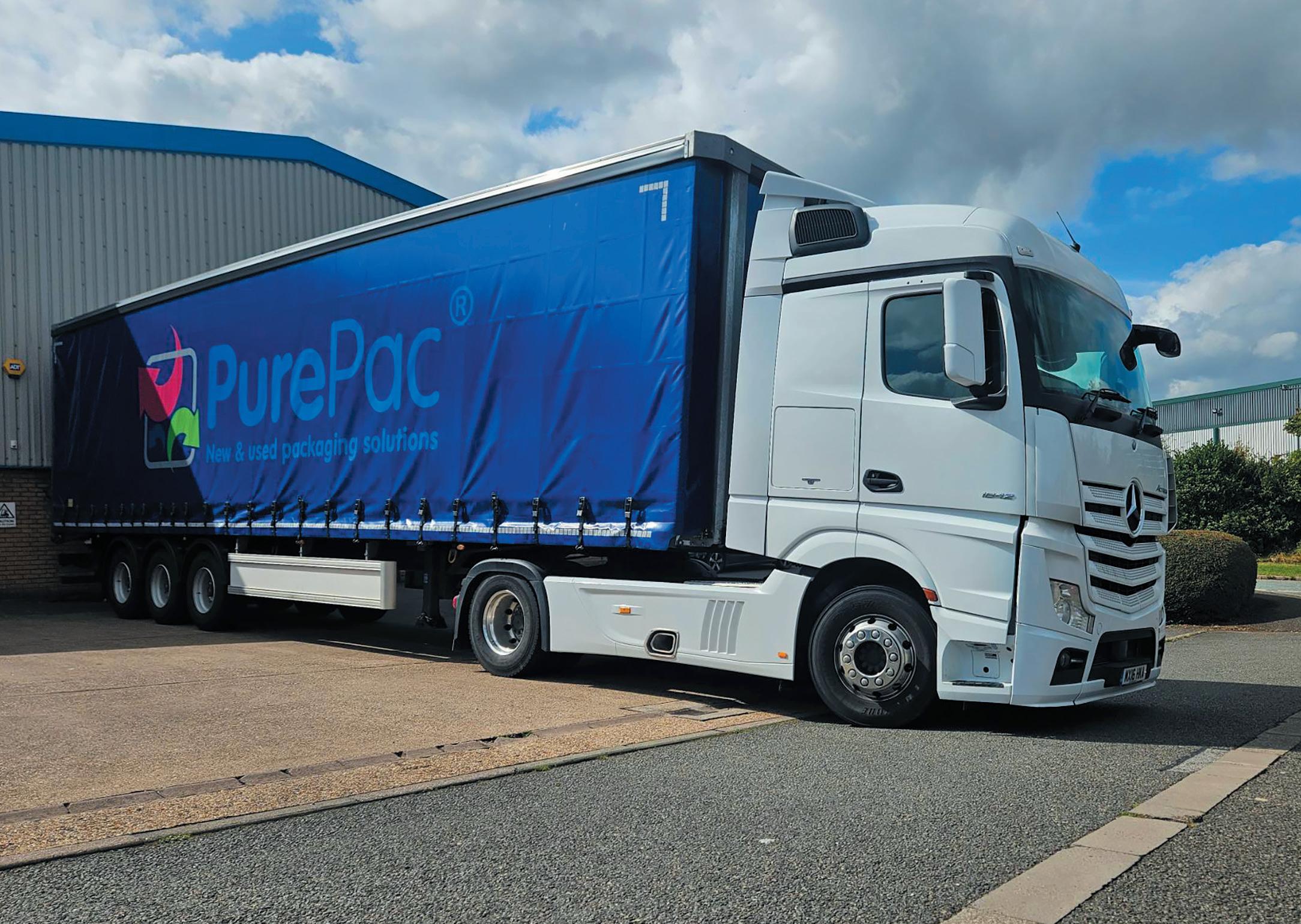
New Launch 50 | STANDARD MAGAZINE winter 2023/24



The TruChecks daily walkaround app comes with full defect and rectification reporting and is easy to use. It saves time, because the drivers don’t need to write stuff down or tick boxes – it’s all on the app.
Chris Brady. Warehouse and Logistics Manager, PurePac
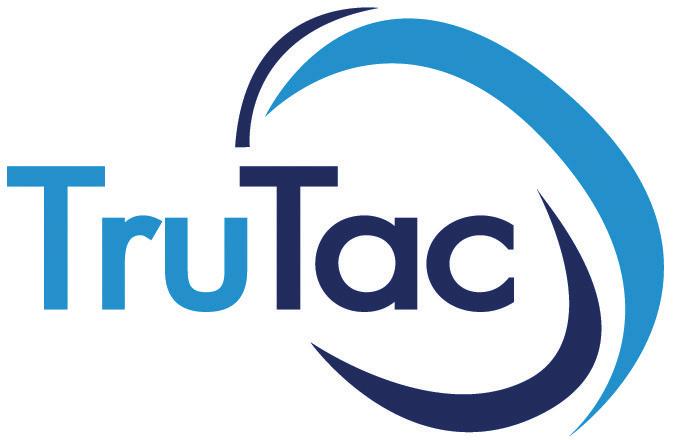
winter 2023/24 STANDARD MAGAZINE | 51 TruTac is ER-accredited
Complete Compliance Control
024 7669 0000 info@trutac.co.uk www.trutac.co.uk
THE QUEEN’S AWARDS FOR ENTERPRISE: INNOVATION 2020
are talking
Driver
+44 (0)1773 537000 www.microlise.com Part of the Microlise Group ID: A00232
We
Paper-Free
Checks!
For 2021, Vision UK is offering safety equipment meeting the requirements of DVS, FORS and CLOCS schemes, to provide a higher level of driver assistance than is required by the guidlines
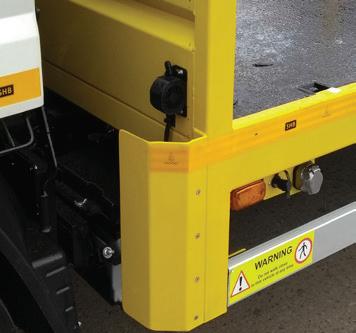
For 2023, Vision UK is offering safety equipment meeting the requirements of DVS, FORS and CLOCS schemes, to provide a higher level of assistance than is required by the guidelines
For 2020, Vision UK is offering safety equipment meeting the requirements of DVS, FORS and CLOCS schemes, to provide a higher level of driver assistance than is required by the guidelines
For 2019 Vision UK are introducing our CLOCS+ System that embraces the spirit of the FORS and CLOCS schemes to provide an even higher level of driver assistance than is required by the guidelines


l Blind Sport Vision System for Construction Logistic Operators
l Vision and Recording System for Construction Logistic Operators
l High Resolution WDR Cameras
l Compliance systems (LDVS-70 SD or HD)

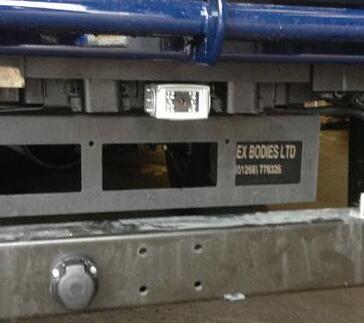
l CLOCS-70 system (system updated for 2020 with HD cameras




Classified 52 | STANDARD MAGAZINE winter 2023/24 Frodsham Business
Frodsham, Cheshire WA6 7FZ www.vision-uk.co.uk 2019 Vision 2019 Driver “Blind Spot” Vision and 360 degree
System for
Frodsham Business Centre, Frodsham, Cheshire WA6 7FZ are introducing our CLOCS+ embraces the spirit of the FORS and provide an even higher level of is required by the guidelines. Front Blind Spot Camera and Detection System to the standsystems, simultaneously providing vision and proximity detection along the side of the vehicle.
Centre,
Vision
Construction Logistic Operators
● Blind Spot Vision System for Construction Logistic Operators
● Vision and Recording System for Construction Logistic Operators
www.vision-uk.co.uk VISION-UK, 43 Westminster Chambers, Hunter Street, Chester CH1 2HR Tel: 0800 731 3316 Fax: 0800 731 3317 E-mail: info@vision-uk.co.uk Vision UK, the UK’s No1 supplier of vehicle vision systems, now offer three system packages specifically designed to meet the requirements of the different FORS levels and CLOCS scheme. ReadyforFORS? Untitled-3 1 20/02/2018 14:11 19/09/2018 13:19
● High Resolution WDR Cameras
©2021 Lytx Inc. All rights reserved. 0221-SUR-300-176
THE NEW GOUPIL G6 100% ELECTRIC, ZERO EMISSIONS GOUPIL ELECTRIC LIGHT COMMERCIAL ROAD VEHICLES WWW.BRADSHAWEV.COM/GOUPIL-ROAD-VEHICLES Goupil - New Goupil G6 - A5.indd 1 12/07/2021 14:11:03
4




Classified winter 2023/24 STANDARD MAGAZINE | 53 We know transport law wards 01254 828 300 backhousejones.co.uk Boutique Firm of the Year The Lawyer Awards 2019 Is your fleet ready for DVS 2024? Get compliant with the new Direct Vision Standard requirements Accurate AI camera technology Ensuring drivers are only alerted when vulnerable road users are around a vehicle rather than static objects Industry-leading experts With over 20 years of experience, fleets can put their trust in us to install kit that is installed correctly, fully compliant, and cost-effective Why choose VUE as your Progressive Safe System supplier? vuegroup.org Become DVS compliant today, call our friendly team on 0161 877 2257

SINGLE BASE MEANS MAXIMUM FLEXIBILITY FOR HYDROGEN TRUCKS
Hydrogen truck innovator HVS reveals new modular platform with two types of e-axle and three tanks
Zero-emission, hydrogenpowered commercial vehicle innovator Hydrogen Vehicle Systems (HVS), has unveiled its modular platform, which offers heavy goods vehicle (HGV) operators maximum flexibility from a single base vehicle.
The company’s tractor unit will be available with two different types of e-axle – one medium power and one high power – and with up to three hydrogen tanks, depending on the customer’s range requirements. In addition, the hydrogen fuel cell powertrain can be specified with two different power outputs depending on the customer’s payload and mission requirements.
The modular platform is built on
a fixed wheelbase, which means the vehicle’s footprint does not change, irrespective of specification.
HVS’ ground-up designed vehicles have been specifically developed to maximise driver comfort while the platform is purpose built around the hydrogen powertrain. The vehicle’s design includes a suspended cab at the front and a fixed tower at the rear, housing the thermal and powertrain systems.
This platform format breaks with the industry standard tradition of variable cab types and sizes – such as big, medium and small, and high/lowroof – and means that even the smallest variants have the same spacious cab as the largest models.
Pete Clarke, head of design at HVS, said: “We’re offering maximum modularity within a single base vehicle platform, and we would never have been able to achieve this level of flexibility and optimisation with a diesel-powertrain derived vehicle design.
“Our vehicles have been created for a fundamentally different technology within an all-new package, so every cubic millimetre has been designed afresh. We initially calculated the maximum wheelbase possible to achieve the required turning circle and manoeuvrability for the target market. The design process then began with the optimal powertrain format, around which the vehicle design was then created –ensuring that form followed function.
The new modular chassis allows for greater flexibility
Words: Matthew Eisenegger
Alternative Fuel 54 | STANDARD MAGAZINE winter 2023/24
“Rather than playing with a configurator, HVS can put the best value package together for customers based on information about what they do, the loads they will carry, along with their ranges and routes.”
Designed for optimum total cost of ownership
The modular platform allows operators to define their HGV specification relative to their operation, while simultaneously transitioning to a zero-emission fleet. HVS’ approach is to ensure that it supplies vehicles in the most appropriate form for the job requirement.
The modular platform’s flexibility is such that the trucks can easily be retrofitted with alternative modules such as additional hydrogen tanks if the fleet’s duties change or expand.
This has the effect of minimising the total cost of ownership (TCO) and provides a compelling business case for early switching to CO2-free vehicles. The company’s emphasis is on price-
per-mile usage and ensuring operators achieve the performance, range and durability they require of this next generation of freight workhorses.
Remake, remodel
Vehicle platform longevity and recycling the electrochemical modules are further benefits of HVS’ modular platform. Its adaptable architecture means core electrochemical modules, including the battery and fuel cell, can be swapped out for fresh equivalents as the technology advances. This future-proofs the vehicle and vastly increases its potential operational life, while other less critical components, such as interior trim or body panels, can also be simultaneously refurbished by HVS when a drivetrain upgrade is performed.
HVS’ approach of refurbishment and replacement enables owners to take advantage of technological advancements much more so than conventional diesel trucks or even current battery electric equivalents.
Speed to market
Clarke said: “HVS is developing new hydrogen drivetrains for its future vehicles, with a focus on delivering maximum power and range for each operational duty class. With this modular platform, HVS offers the best available technology, meaning that its 4x2 tractor unit provides a highly competitive, zeroemission range of up to 370 miles/600 kilometres.
“This enables operators to transition to a zero-emission fleet as soon as possible, by providing early learning opportunities at low risk and affordable costs.
“The interchangeability of the modular platform means more advanced modules can be added as the penetration of hydrogen HGVs into the market increases and technology matures and benefits from economies of scale, while early adopters will benefit from the knowledge, experience and market profile of operating hydrogen HGVs as part of the necessary transition to low carbon technology.” ◼
We would never have been able to achieve this level of flexibility and optimisation with a diesel-powertrain derived vehicle design
 The new hydrogen powered truck from HVS
The new hydrogen powered truck from HVS
Alternative Fuel winter 2023/24 STANDARD MAGAZINE | 55









Classified ADVERTISE IN CV DRIVER MAGAZINE Reaching HGV Drivers, Industry Figures and Business Owners across the Transport & Logistic industry has never been so easy! Rates from as little as £49 per issue cvdriver.com HAY GOOD LOOKING P&L FORMAN VICTORIOUS AT DAF’S VIRTUAL TRUCK SHOW –SILVER STUNNER! AAD TRANSPORT SMARTENS UP ITS FLEET WITH THIS SUPERB MERC ACTROS HAY GOOD LOOKING –SILVER STUNNER! AAD TRANSPORT SMARTENS UP ITS FLEET WITH THIS SUPERB MERC ACTROS PUTTING THE ROLL IN ROCK We turn the spotlight on the fleet that GREEN PATH AHEAD Looking at how the truck manufacturers are WHO’S BUYING WHAT Round-up of the latest truck acquisitions YOUR EDITOR SAYS... LEGAL EAGLE accident while making deliveries SAFE AND SECURE IVECO’S HIGH FLIER! S-WAY GETS ALL TOGGED UP IN ALCALINE’S LATEST DAZZLING LIVERY Issue 102 February 2021 PUTTING THE ROLL IN ROCK GREEN PATH AHEAD WHO’S BUYING WHAT IVECO’S HIGH FLIER! S-WAY GETS ALL TOGGED UP IN ALCALINE’S LATEST DAZZLING LIVERY Issue 102 // February 2021 Call: 01388 517906 or 07590 547343 Email: sales@cvdriver.com or djohns-mediasales@hotmail.co.uk
Words: Ian Jones, Backouse Jones Solicitors
SAVE COSTS & HASSLE WITH MEDIATION
Going to court in the event of a staffing issue is an expensive business – talking is much cheaper
Mediation is a flexible, voluntary and confidential form of alternative dispute resolution, in which a neutral third party (a mediator) assists parties to work towards a negotiated settlement acceptable for both sides. The trained mediator will listen to all views, talk to both parties privately and come to a mutually agreeable solution. Mediation can help preserve your commercial relationships. Settling a dispute through an adversarial court battle can put added pressure on the relationship between both parties.
The mediation agreement will usually require the parties to treat all discussions and documents as confidential and without prejudice. This means that what is said or written cannot be used in later proceedings if the mediation does not settle, with some limited exceptions.
Mediation can take place at any time before your case reaches a hearing or trial at court and the best time will often depend on your individual case.
It is best to try mediation as soon as you can. This will help reduce the amount of time and money spent on the dispute and open a dialogue with the other party before they become too fixed in their position.
Advantages of mediation
The legal costs can be reduced substantially through mediation. Progressing and settling a dispute through court proceedings is particularly expensive. The overall costs can be extremely unpredictable and with barristers’ fees and court fees, the legal costs can soon outweigh the amount in dispute.
As well as being significantly cheaper, mediation can also save you considerable time and stress. Court dates are usually
scheduled way in advance, and you could find yourself waiting years before you get into court, while a mediation date can be arranged within months or even weeks.
As well as being significantly cheaper, mediation can also save you time and stress
While mediation does not guarantee you will resolve the dispute, the fact that no binding decision is made means that both parties have more control over the solution, and are not forced to accept an outcome in which they are not satisfied. If you take a matter to court, you are stuck with the decision of the judge (subject to appeal). We also often
find that if a dispute does not settle at a mediation, it may well settle shortly afterwards.
Recent changes
As of 1 October 2023, amendments to the Civil Procedure Rules for England & Wales see a new regime of fixed recoverable costs (FRC) in all fast-track claims (ie. up to the value of £25k) and for a separate FRC regime to apply to claims that are valued in excess of that but less than £100k.
The higher value cases will now proceed to a new track, the intermediate track, and will be subject to new fixed cost rules. In view of the new regime, it would seem that now is a better time than ever to consider mediation as an alternative form of dispute resolution as, even if you go to court and win your claim, you will only be able to recover a fixed amount for your legal costs and this will likely be a lot less than what you will have paid to your legal team. ◼
Below: It is best to try mediation as soon as you can. This will help reduce the amount of time and money spent on the dispute

Legal winter 2023/24 STANDARD MAGAZINE | 57

Classified 58 | STANDARD MAGAZINE winter 2023/24





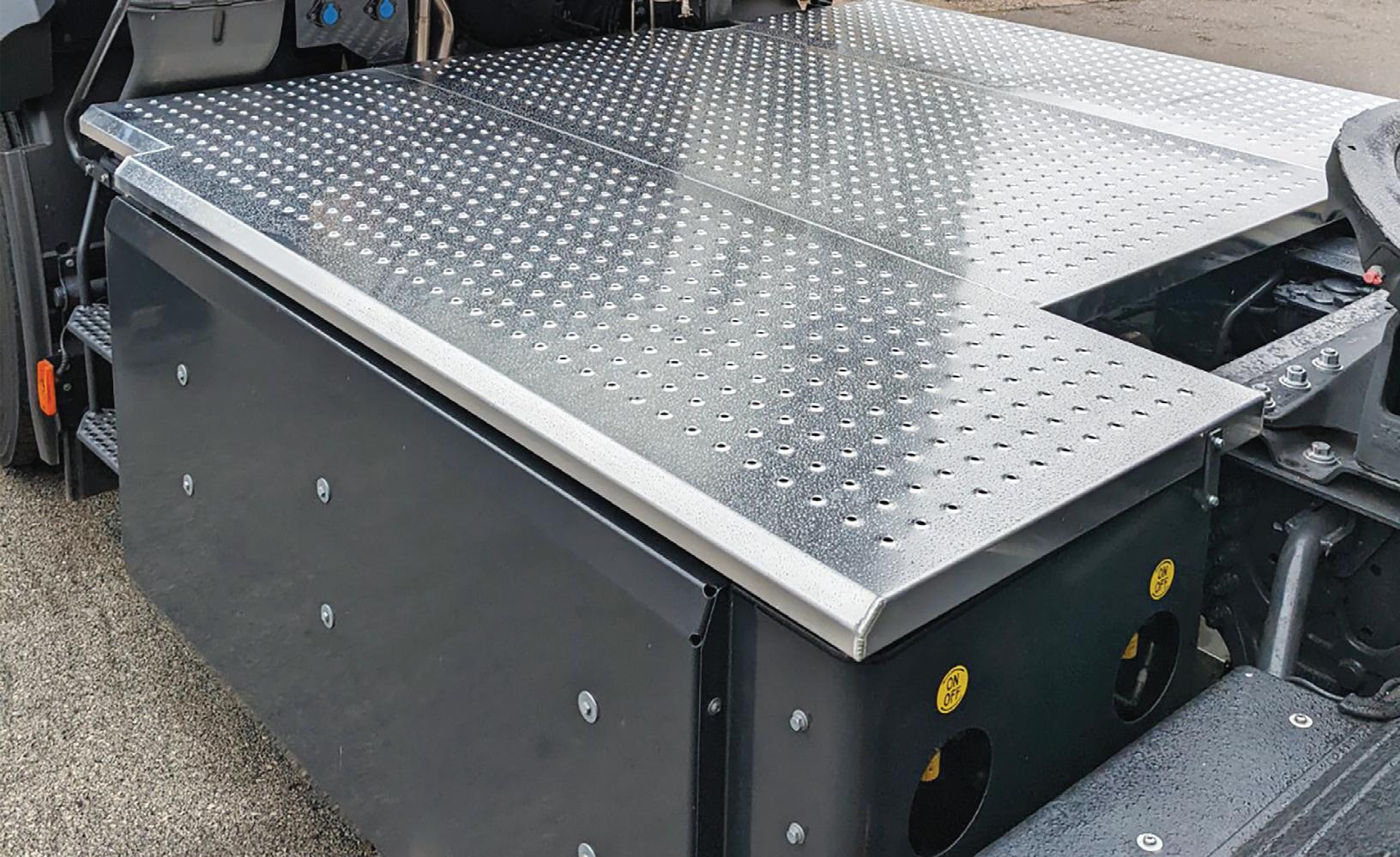


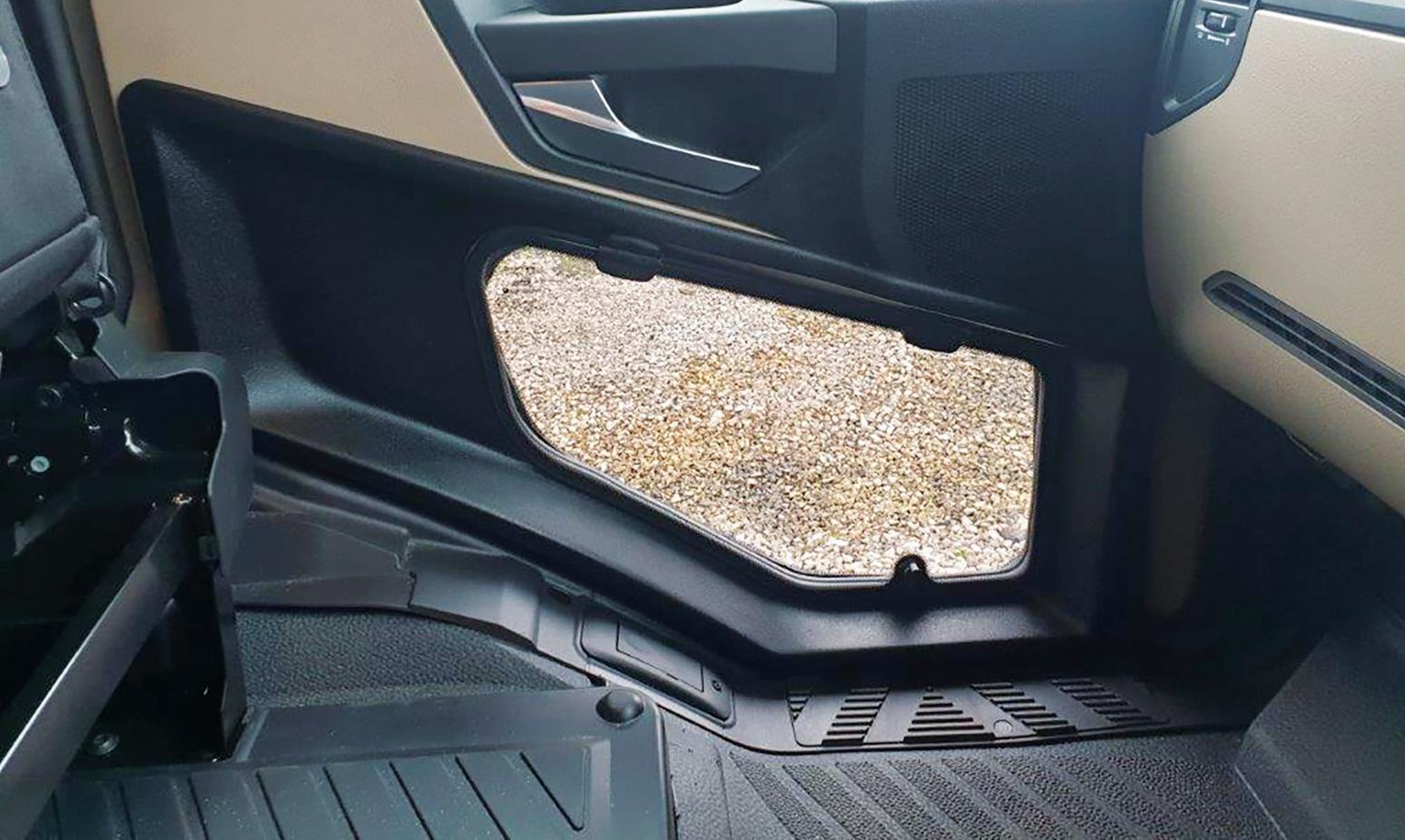


Classified winter 2023/24 STANDARD MAGAZINE | 59 MAGAZINE Advertising Sales: David Johns Telephone: 01388 517 906 Mobile: 07590 547 343 Email: sales@thestandardmagazine.co.uk ADVERTISE WITH US Standard Magazine is committed to bringing you the latest news, information and guidance regarding compliance, legislation and regulations for road transport Talk to the experts: +44 (0)151 348 5777 sales@astra-vt.com / astra-vt.com First call for specialist vehicle engineering (chassis modification & vehicle conversions) ID: A00432 AVT’s eet preparation team can provide innovative tailored solutions to suit your eet requirements with a wide range of products, support, and a dedicated 3D CAD department, all creating a one stop shop in an effort to reduce build times and save unnecessary and costly vehicle movements, getting your eet on the road as quickly and cost effectively as possible. Fleet Preparation and Accessories Innovative tailored solutions to suit your fleet requirements CUSTOM CATWALKS SPLIT CHARGE SYSTEMS CAMERA SAFETY SYSTEMS AVT CLEARVIEW HANDBRAKE & REVERSE ALARMS RAISED A FRAMES SIDE SKIRTS UNDER TANK PROTECTION SUZIE PARK PLATES TRAILER RUN UP RAMPS FIRE EXTINGUISHER KITS WHEEL CHOCK KITS Blind Spots in Heavy Goods and Construction vehicles Astra ClearView – low level passenger door windows help to improve direct vision by reducing the blind spot area, whilst maintaining full operation of the electric side window. Astra CLEARVIEW Innospec Manufacturing Park, Oil Sites Road, Ellesmere Port, Cheshire CH65 4EY Astra 185x135_02-2023.qxp_Layout 1 23/05/2023 9:33 am Page 1







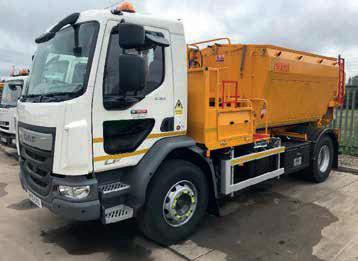




INSULATED DROPSIDE & CAGED TIPPER VEHICLES








DROPSIDE & R VEHICLES
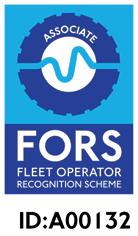




FIXED & DROPSIDE TIPPER GRABS, PEU’S & CRANE VEHICLES
SIDE TIPPER RANE VEHICLES
SKIP / HOOK LOADER, SWEEPER & GULLY EMPTIER MUNICIPAL VEHICLES



Email: enquiries@ndbrown.co uk, Phone: 01902 791991, Web: www ndbrown co uk
Depots In: West Midlands (Head Office) - rlingshire - Devon - Kent - Belfast

OK LOADER, ULLY EMPTIER AL VEHICLES
STREET LIGHTING VEHICLES, BUILDERS MERCHANT VEHICLES AND DROPSIDES WITH CRANES





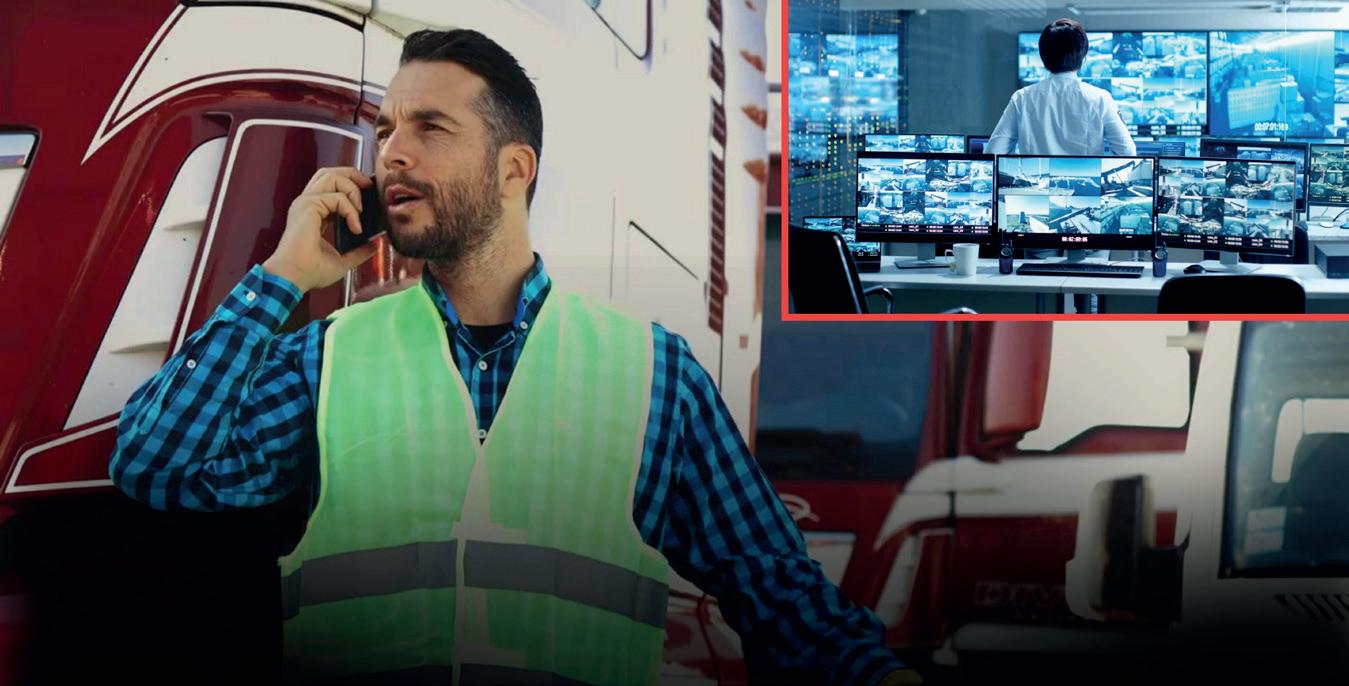


Classified 60 | STANDARD MAGAZINE winter 2023/24 Contact us today to find out more and to join the bebo experience! Give us a call on 0845 468 0812 or email us at info@re-techuk.co.uk AI Technology RE-Tech.co.uk 0845 468 0812 safe | smart | efficient | compliant Staying DVSA compliant can be a real challenge. Tick that box with bebo‘s game-changing AI solutions. Body INSULATED DROPSIDE & CAGED TIPPER VEHICLES FIXED & DROPSIDE TIPPER GRABS, PEU’s & CRANE VEHICLES SKIP / HOOK LOADER, SWEEPER & GULLY EMPTIER MUNICIPAL VEHICLES Email: enquiries@ndbrown.co uk, Phone: 01902 791991, Web: www ndbrown co uk Depots In: West Midlands (Head Office) - rlingshire - Devon - Kent - Belfast Supplying the ity, Municipal, Highway Maintenance and Environmental Service sectors with Specialist SelfDrive Commercial Vehicle Hire for over 4 decades www.ndbrown.co.uk FORS SI L VER S T ANDARD A Carbon Assessed & Carbon Neutral Organisation Since 2020 VEHICLE SALES - Offering commercial vehicles from our ex-rental fleet or new SERVICE & REPAIR - Our in-house fully trained mobile service engineers cover all MOBILE, STATIC & TOWABLE HOTBOXES AND ECON ROADMENDERS VEHICLE HIRE - Supplying over 790 modern high specifica�on commercial vehicles na�onally, from our 5 depots. Supplying a fleet of over 1000 high specification, self-drive commercial vehicles from five depots nationally.
MOBILE, STATIC & TOWABLE HOTBOXES AND ECON ROADMENDERS
Body
upplying
and Environmental
over 4 decades
- Offering commercial vehicles from our ex-rental fleet or new SERVICE & REPAIR - Our in-house fully trained mobile service engineers cover all MOBILE, STATIC
TOWABLE
AND ECON ROADMENDERS
HIRE - Supplying over 790 modern high specifica�on commercial vehicles na�onally, from our 5 depots. Body INSULATED DROPSIDE & CAGED TIPPER VEHICLES FIXED & DROPSIDE TIPPER GRABS,
www ndbrown co uk Depots In: West Midlands (Head Office) - rlingshire - Devon - Kent - Belfast Supplying the ity, Municipal, Highway Maintenance and Environmental Service sectors with Specialist SelfDrive Commercial Vehicle Hire for over 4 decades www ndbrown.co.uk FORS SI L VER S T ANDARD A Carbon Assessed & Carbon Neutral Organisation Since 2020 VEHICLE SALES - Offering commercial vehicles from our ex-rental fleet or new SERVICE & REPAIR - Our in-house fully trained mobile service engineers cover all MOBILE, STATIC & TOWABLE HOTBOXES AND ECON ROADMENDERS VEHICLE HIRE - Supplying over 790 modern high specifica�on commercial vehicles na�onally, from our 5 depots. Body INSULATED DROPSIDE & CAGED TIPPER VEHICLES FIXED & DROPSIDE TIPPER GRABS, PEU’s & CRANE VEHICLES SKIP / HOOK LOADER, SWEEPER & GULLY EMPTIER MUNICIPAL VEHICLES Email: enquiries@ndbrown.co uk, Phone: 01902 791991, Web: www ndbrown co uk Depots In: West Midlands (Head Office) - rlingshire - Devon - Kent - Belfast Supplying the ity, Municipal, Highway Maintenance and Environmental Service sectors with Specialist SelfDrive Commercial Vehicle Hire for over 4 decades www ndbrown.co.uk FORS SI L VER S T ANDARD A Carbon Assessed & Carbon Neutral Organisation Since 2020 VEHICLE SALES - Offering commercial vehicles from our ex-rental fleet or new SERVICE & REPAIR - Our in-house fully trained mobile service engineers cover all MOBILE, STATIC & TOWABLE HOTBOXES AND ECON ROADMENDERS VEHICLE HIRE - Supplying over 790 modern high specifica�on commercial vehicles na�onally, from our 5 depots.
the ity, Municipal, Highway Maintenance
Service sectors with Specialist SelfDrive Commercial Vehicle Hire for
www.ndbrown.co.uk FORS SI L VER S T ANDARD VEHICLE SALES
&
HOTBOXES
VEHICLE
PEU’s & CRANE VEHICLES SKIP / HOOK LOADER, SWEEPER & GULLY EMPTIER MUNICIPAL VEHICLES Email: enquiries@ndbrown.co uk, Phone: 01902 791991, Web:

Discover the Power of Volvo
Contact your local Volvo Trucks dealer about the full Volvo Distribution range with Volvo FL Electric
Enjoy leaner, quieter, more efficient delivery in the city. The Volvo FL Electric is compact, agile, and engineered to run smoothly any time of day or night – ensuring efficient, electric urban transport, with zero tailpipe emissions.
Volvo Trucks. Driving Progress.


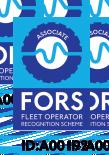



Tyres for regional, urban and on & off road. 100% regroovable and retreadable to maximise the tyre life, resulting in increased mileage and cost savings. Efficient and reliable, and designed to deliver maximum mileage performance, making them the right choice for every transport professional.


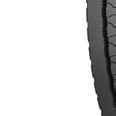


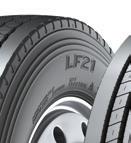



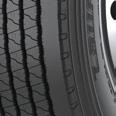

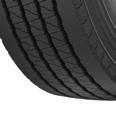












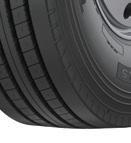






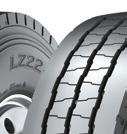

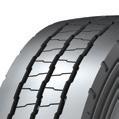






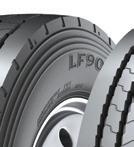


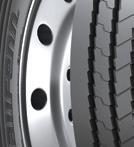

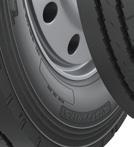





































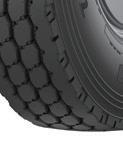



















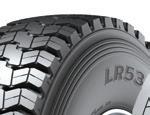

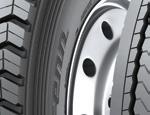











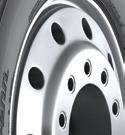




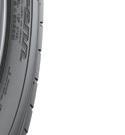

62 | STANDARD MAGAZINE winter 2023/24 ID: A00192 jhaama-v2.indd 1 14/06/2023 16:12
Scan the QR code to find out more
A brand by Hankook Tire
Discover our truck and bus tyres

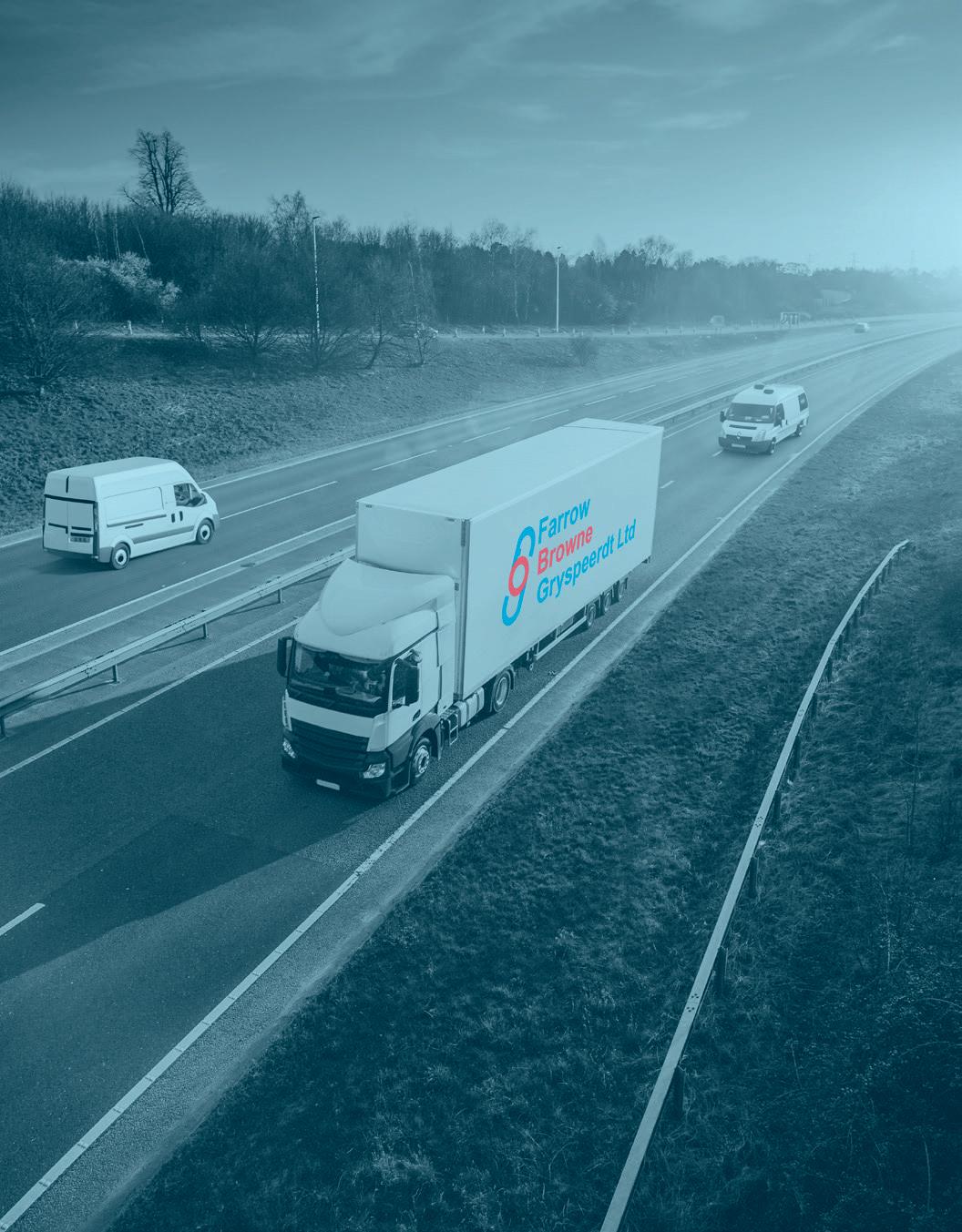



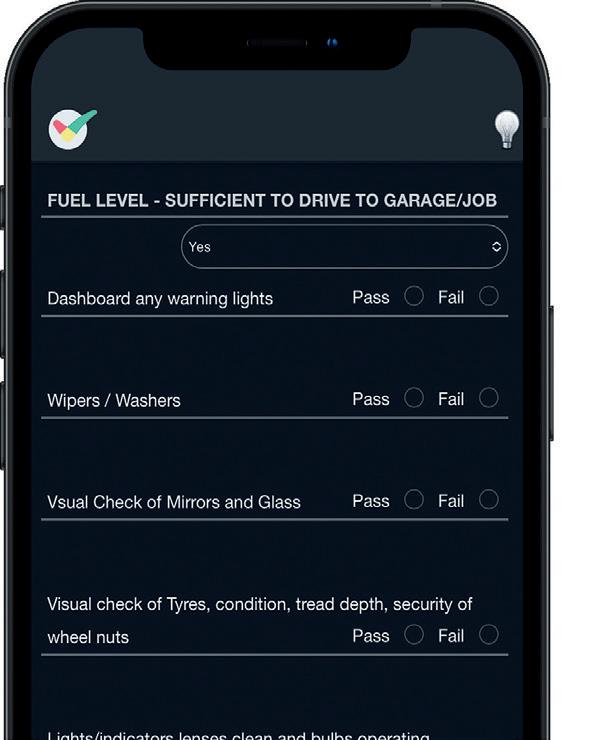
Classified winter 2023/24 STANDARD MAGAZINE | 63 SMART RADAR DETECTIONSIDEFOR Radar Predict Side-detection radar system with Artificial Intelligence that warns the driver only when a collision with a cyclist is predicted. 01322 420 300 brigade-electronics.com Scan for more information Independently certified to comply with current and progressive DVS requirements Paperless defect reporting and fleet maintenance £1 per vehicle, per week Try free for 30 days checkedsafe.com Now offering DVLA ADD Driver Licence Checks Farrow Browne Gr yspeerdt Ltd APPROVED CENTRE AC01840 info@fbgtraining.com www.fbgtraining.com 01634 393236 COURSES • FORS PROFESSIONAL • DRIVERS HOURS • DRIVER VEHICLE CHECKS • FIRST AID SCAN THIS QR CODE FOR A FORS DISCOUNT CODE VEHICLE TRAINING Visit our website for more courses LoCITY DRIVING • FORS PROFESSIONAL • ALTERNATIVE FUELLED SAFE DRIVING (NEW!)




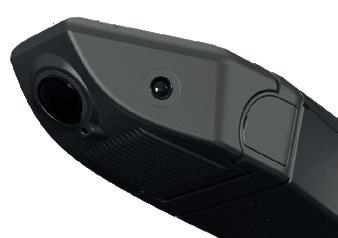





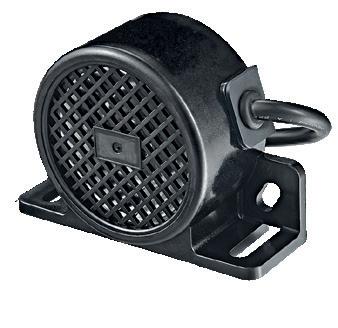










durite.co.uk Durite, Leaders in Vehicle Safety. From DVR and 4G DVR kits, FORS compliant kits and DVS Progressive Safe Systems, all our kits are E-marked and come with an extended warranty as standard. We offer free demos and bespoke solutions, and for your peace of mind, installation services are available UK-wide. Introducing our fully compliant All-in-One Progressive Safe System (PSS). ENJOY A SMOOTH TRANSITION TO DVS PHASE 2 WITH DURITE PRE ORDER TODAY - PART NO. 4-774-50 DVS PROGRESSIVE SAFE SYSTEM (PSS) Tel: +44 (0) 1255 555200 | Email: sales@durite.co.uk | Website: www.durite.co.uk SCAN TO ENQUIRE NOW CONTACT THE SAFETY EXPERTS DVS@DURITE.CO.UK OR 01255 555 209 2 Q UALITY ASSURE D WARRANTY YEAR




 Truck Lens
Extra 30O Forward Vision
Truck Lens
Extra 30O Forward Vision










































 Anthony Marcou – everyone can help to improve road safety
Anthony Marcou – everyone can help to improve road safety

































































































































 The new hydrogen powered truck from HVS
The new hydrogen powered truck from HVS






























































































































































































